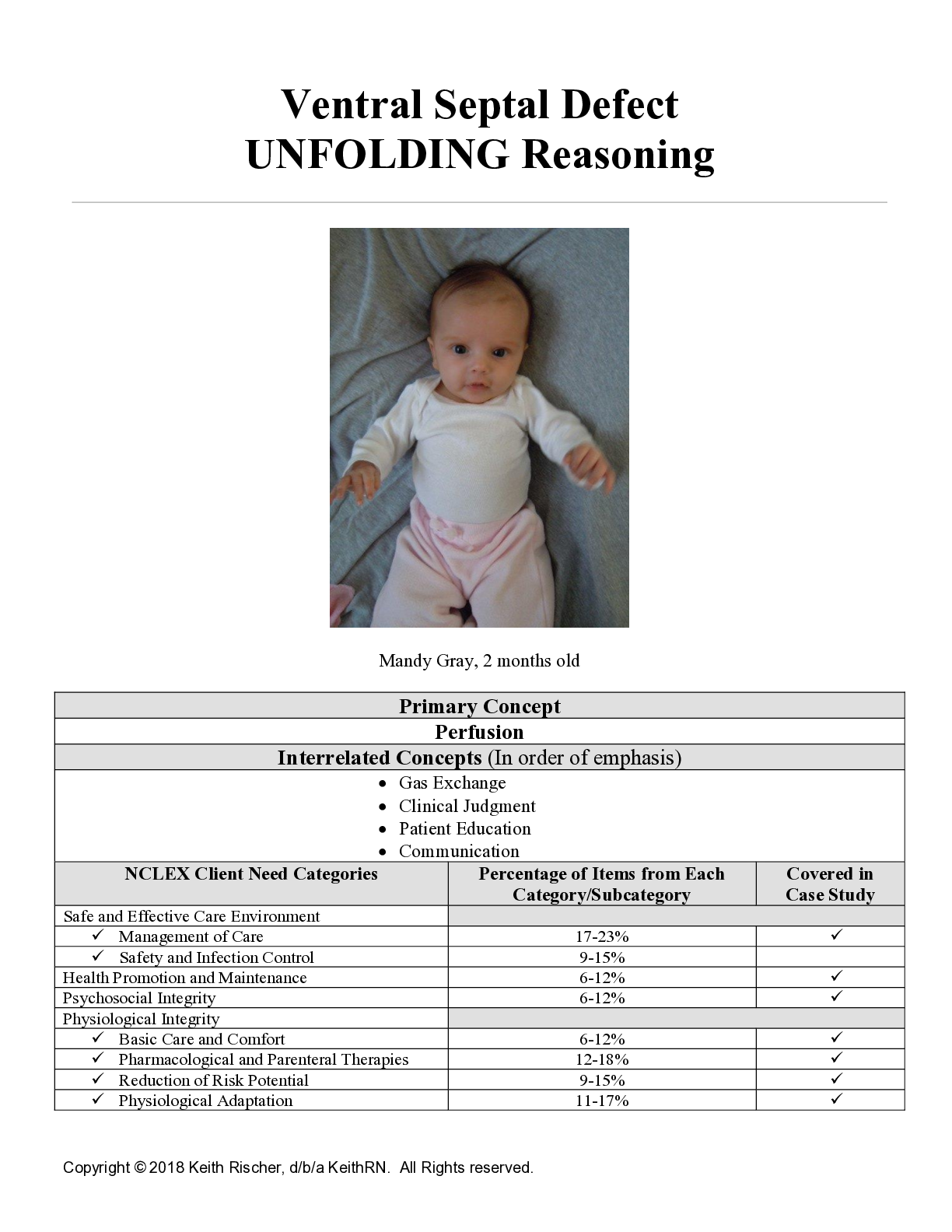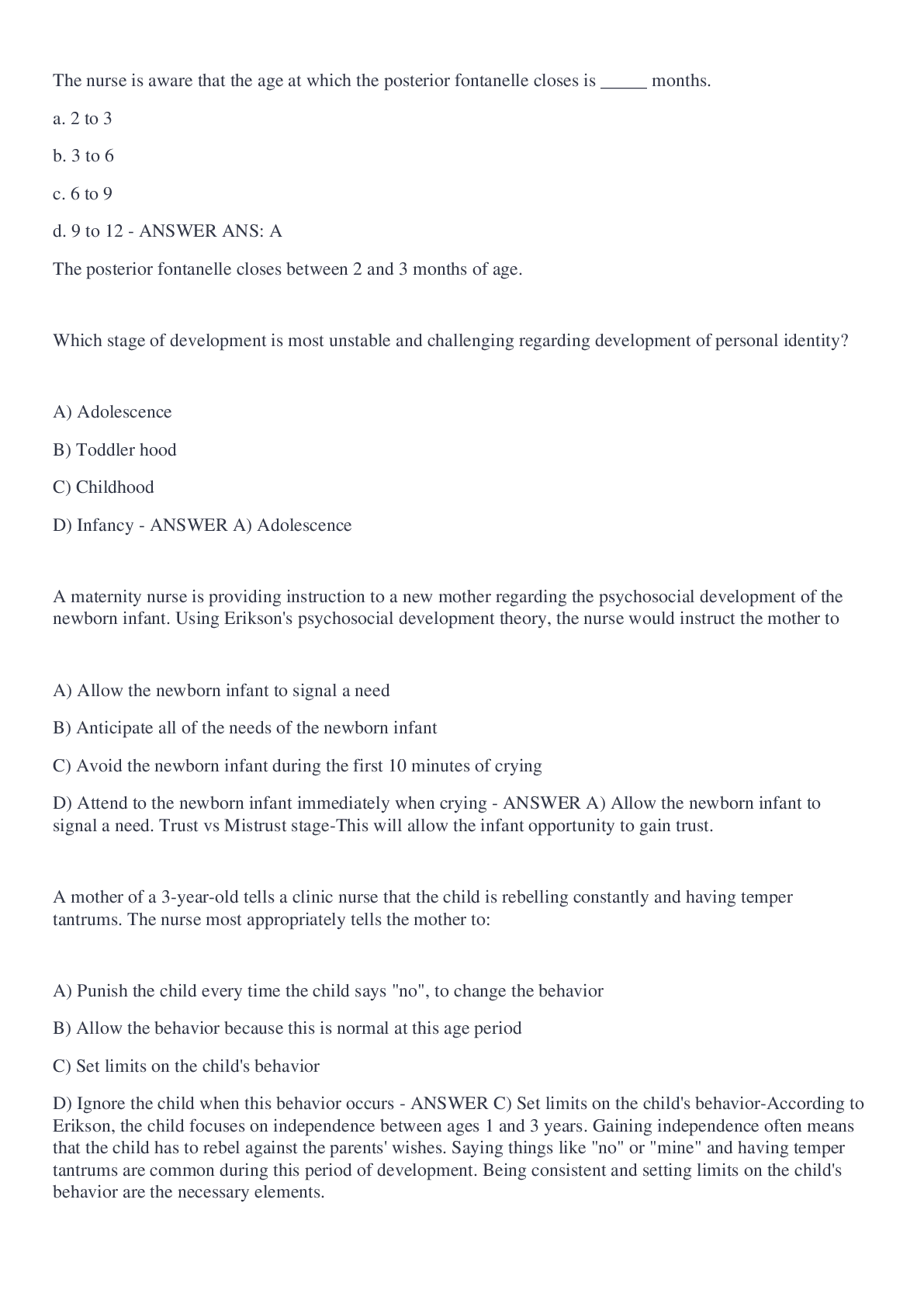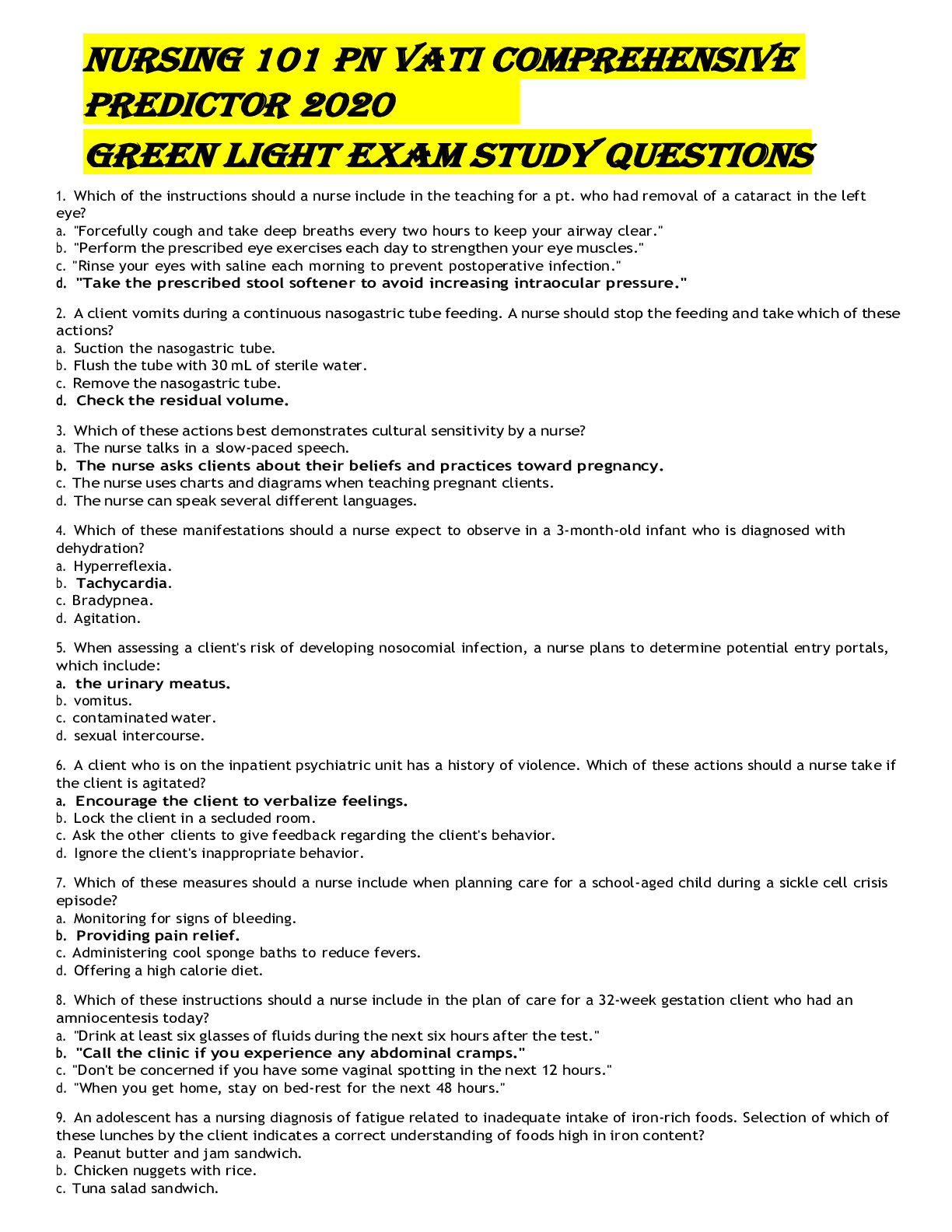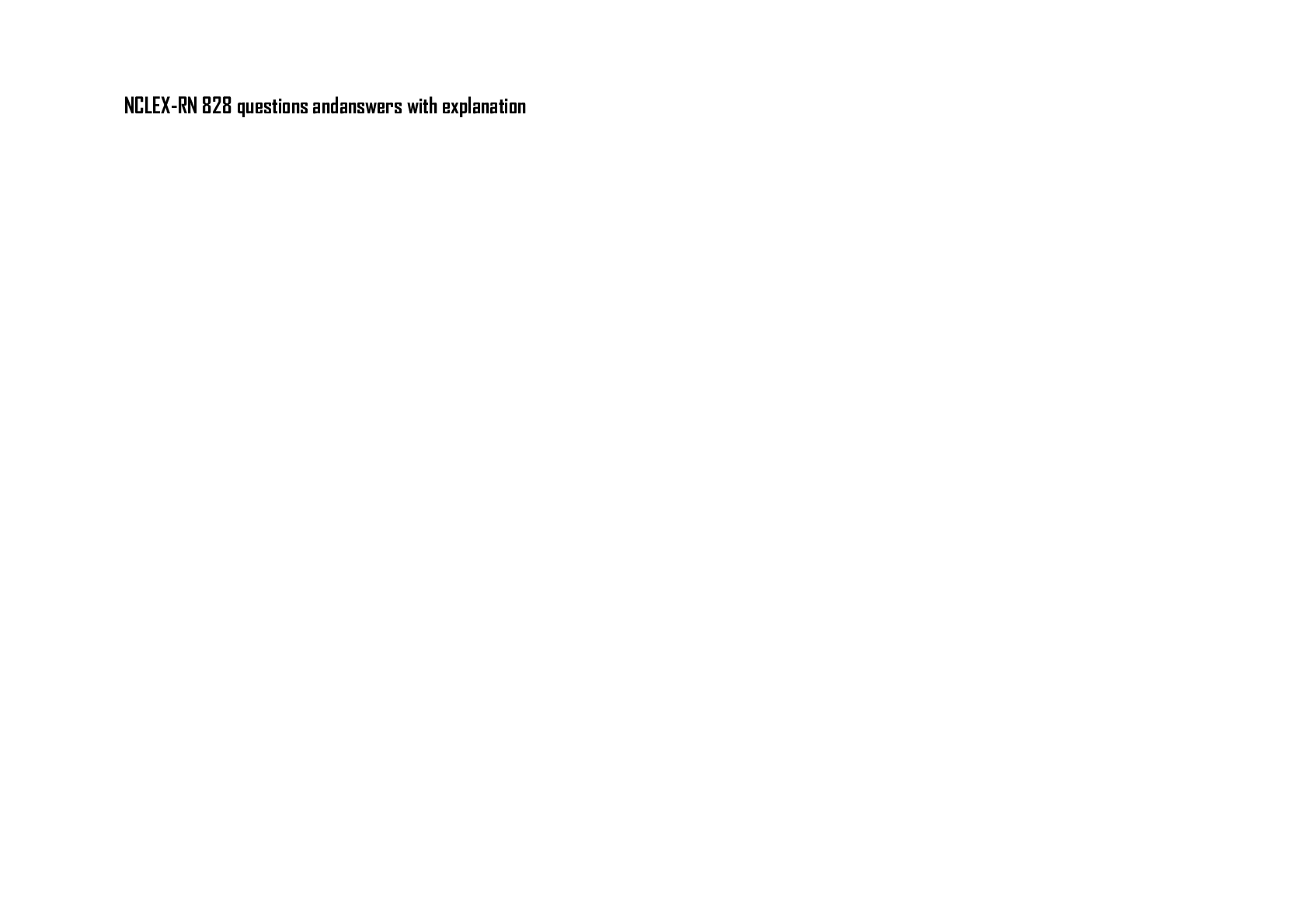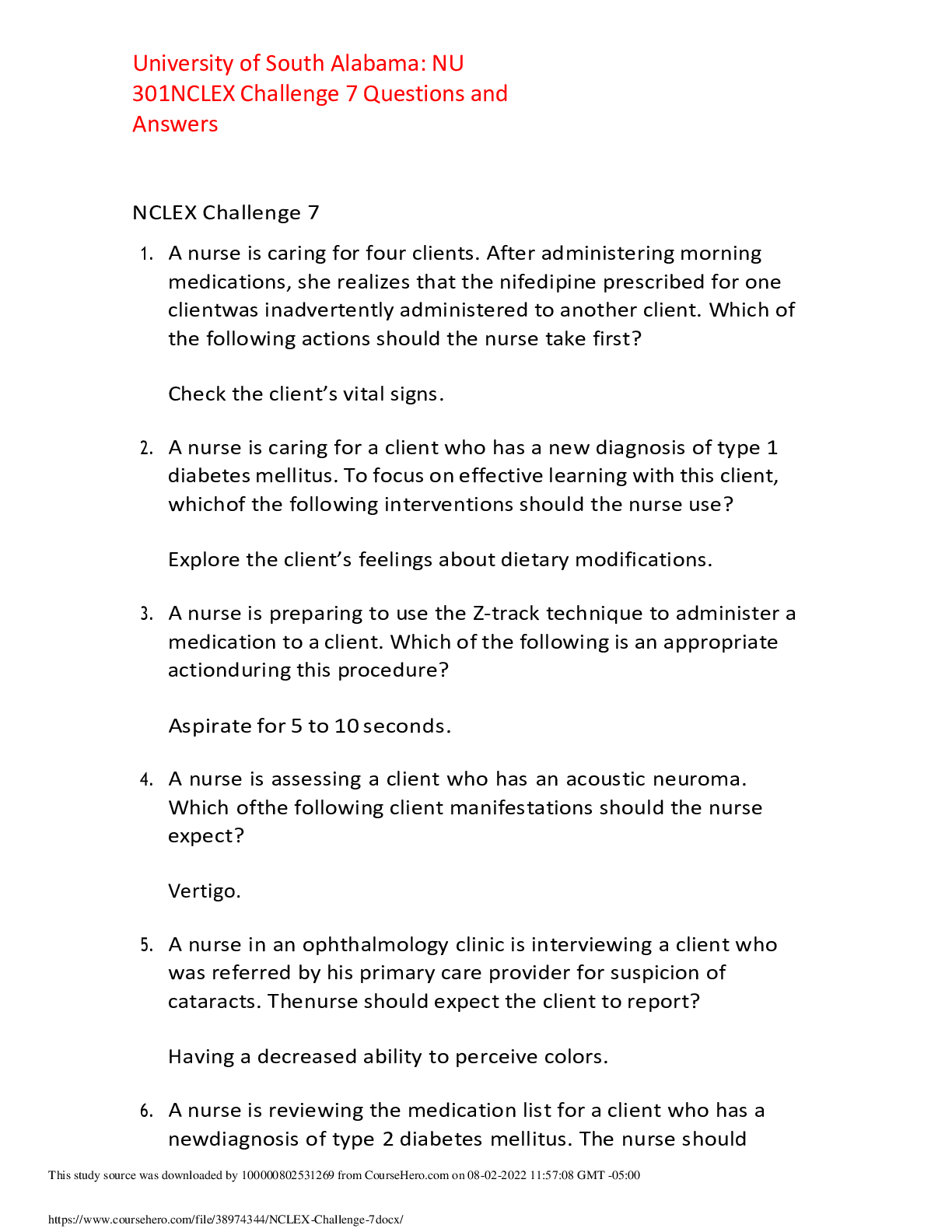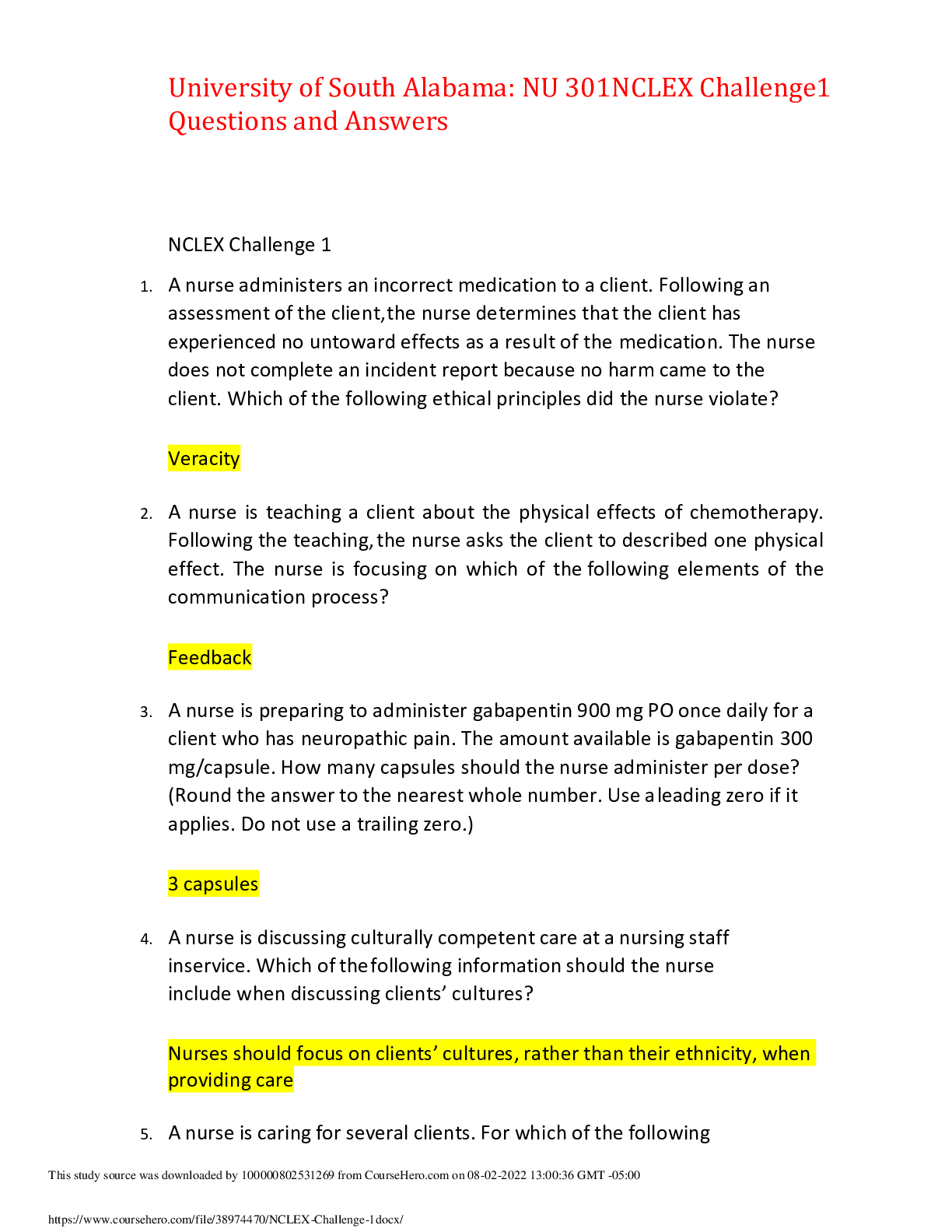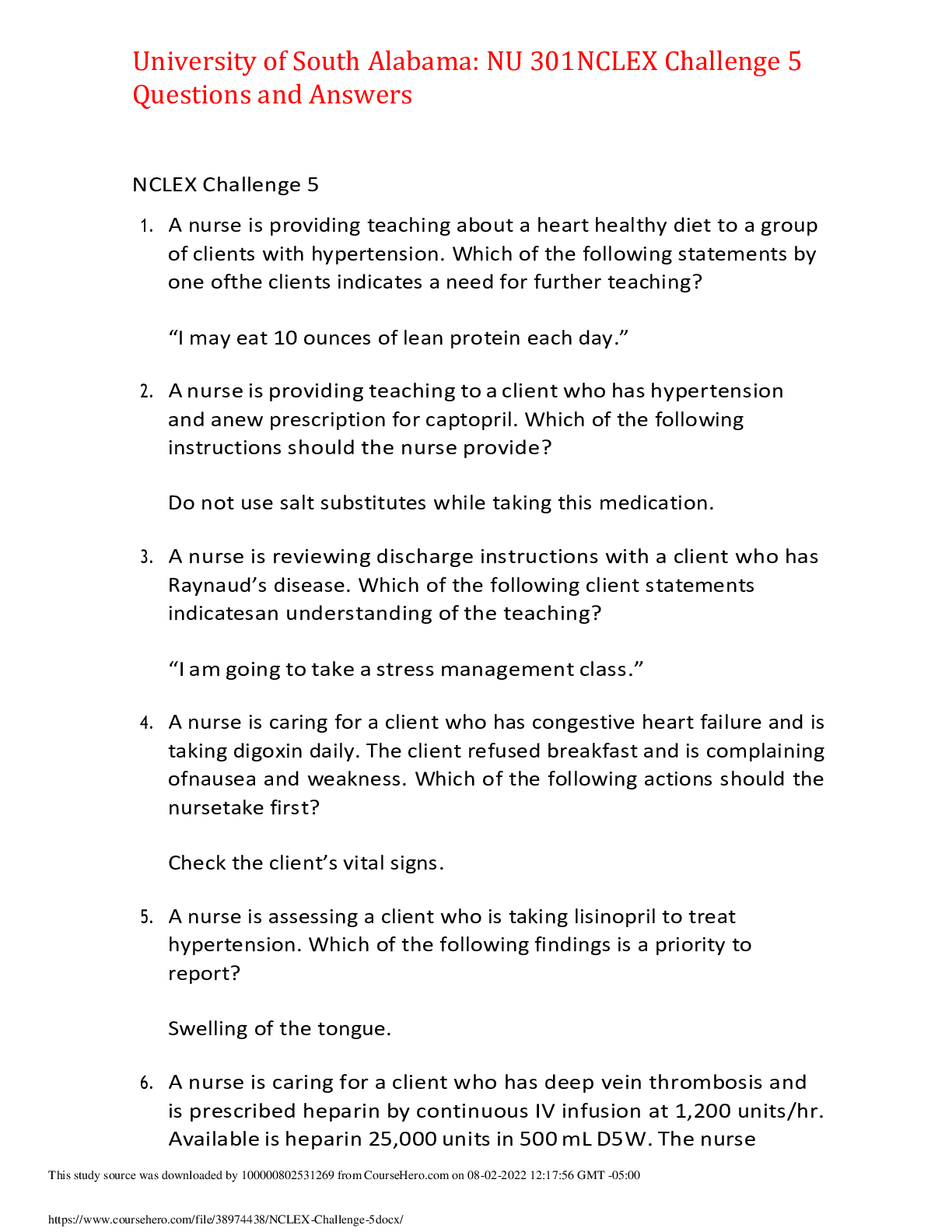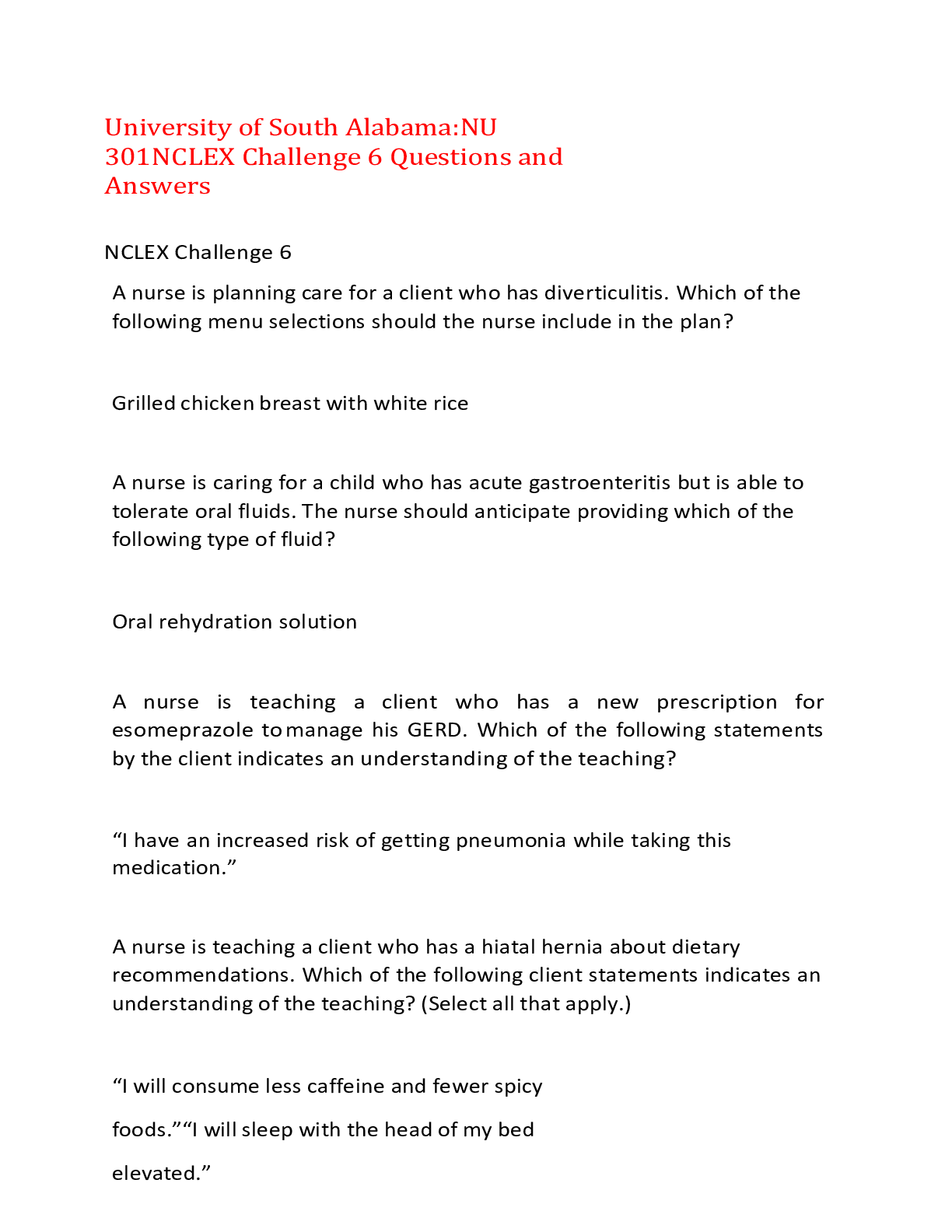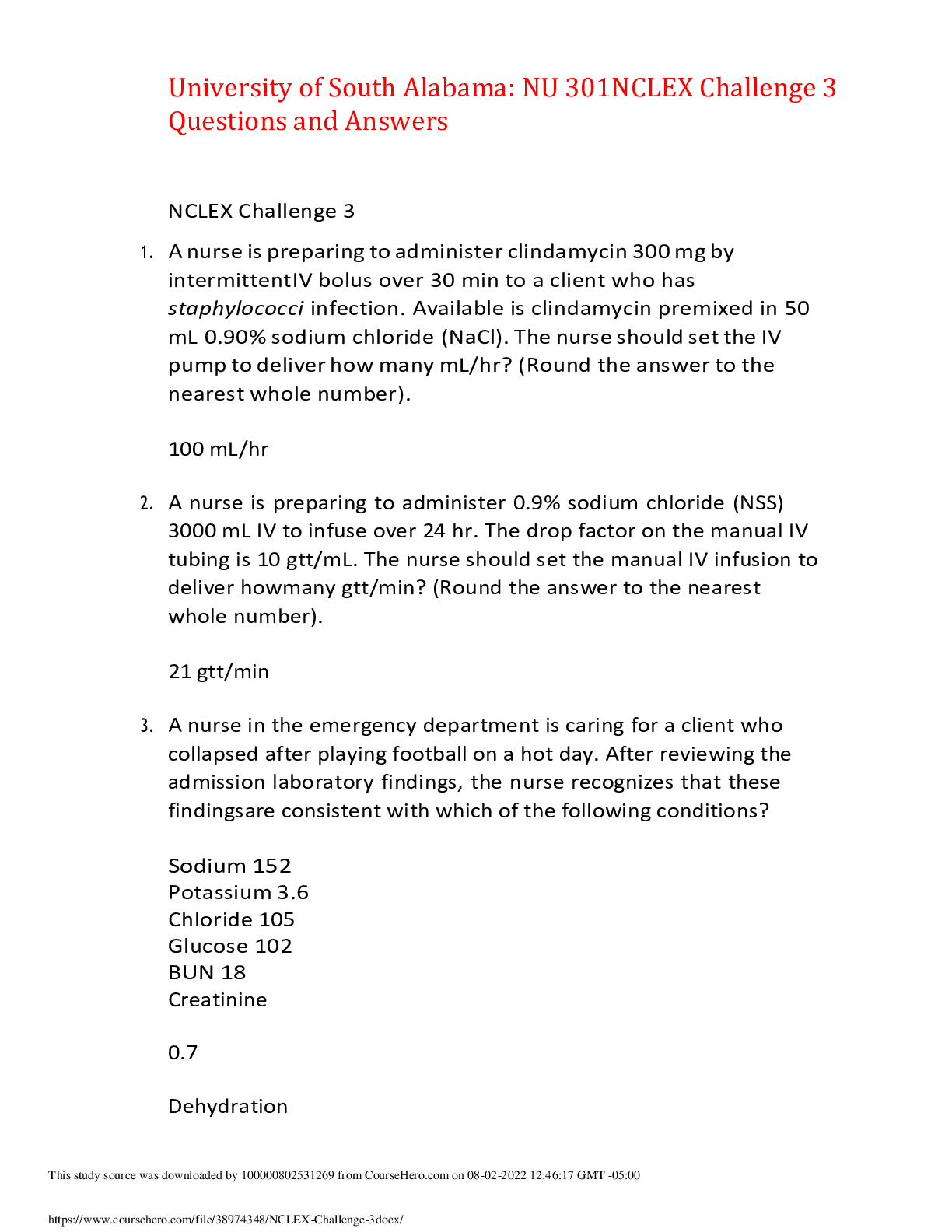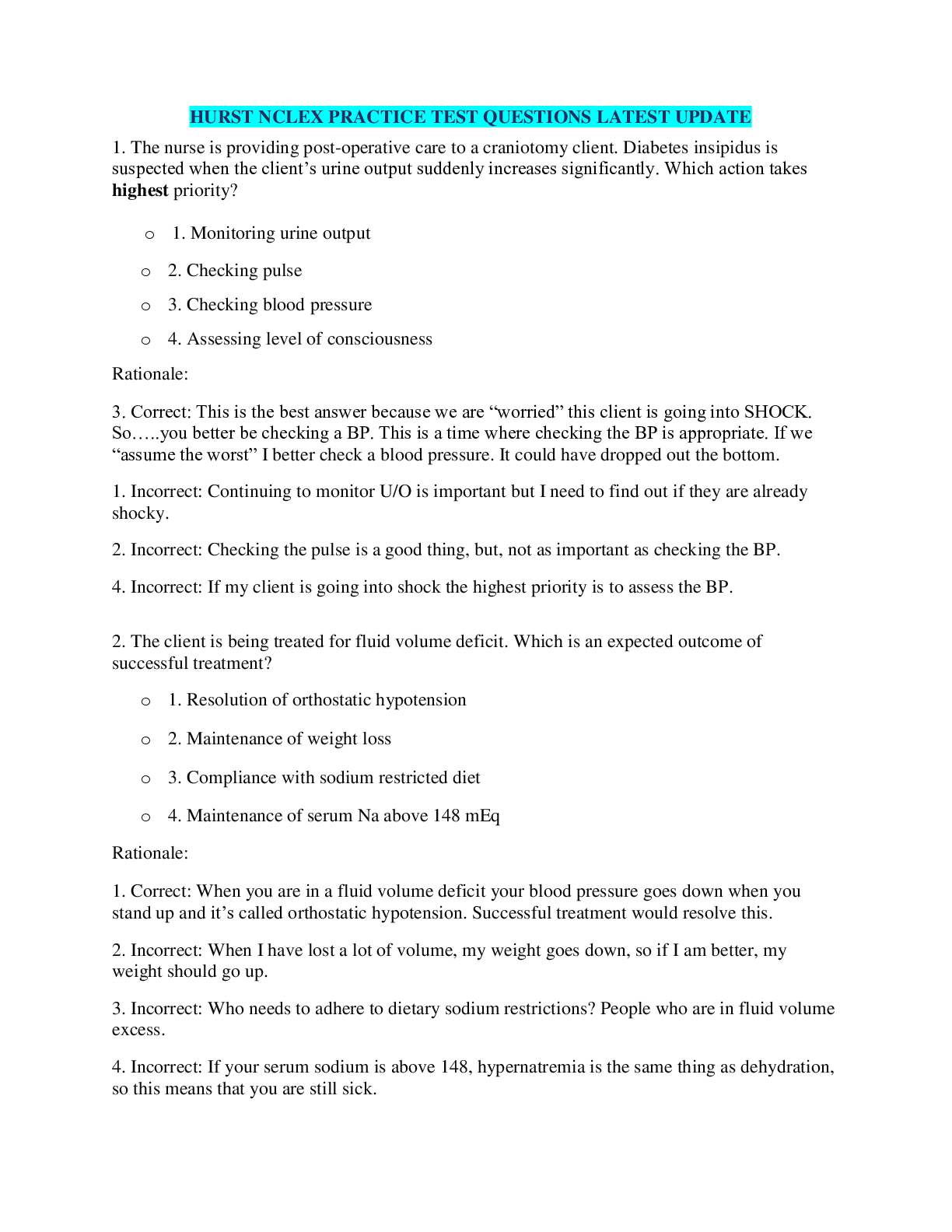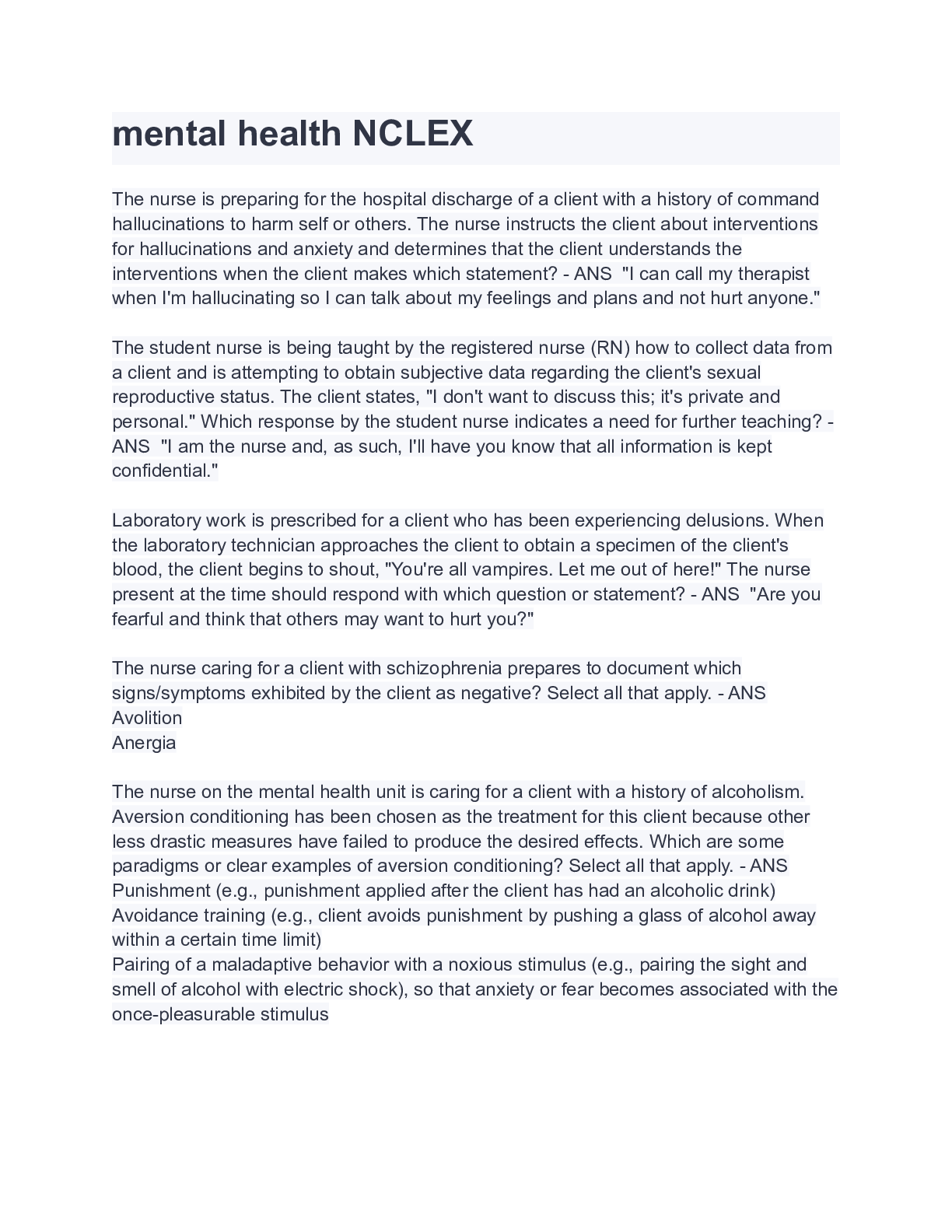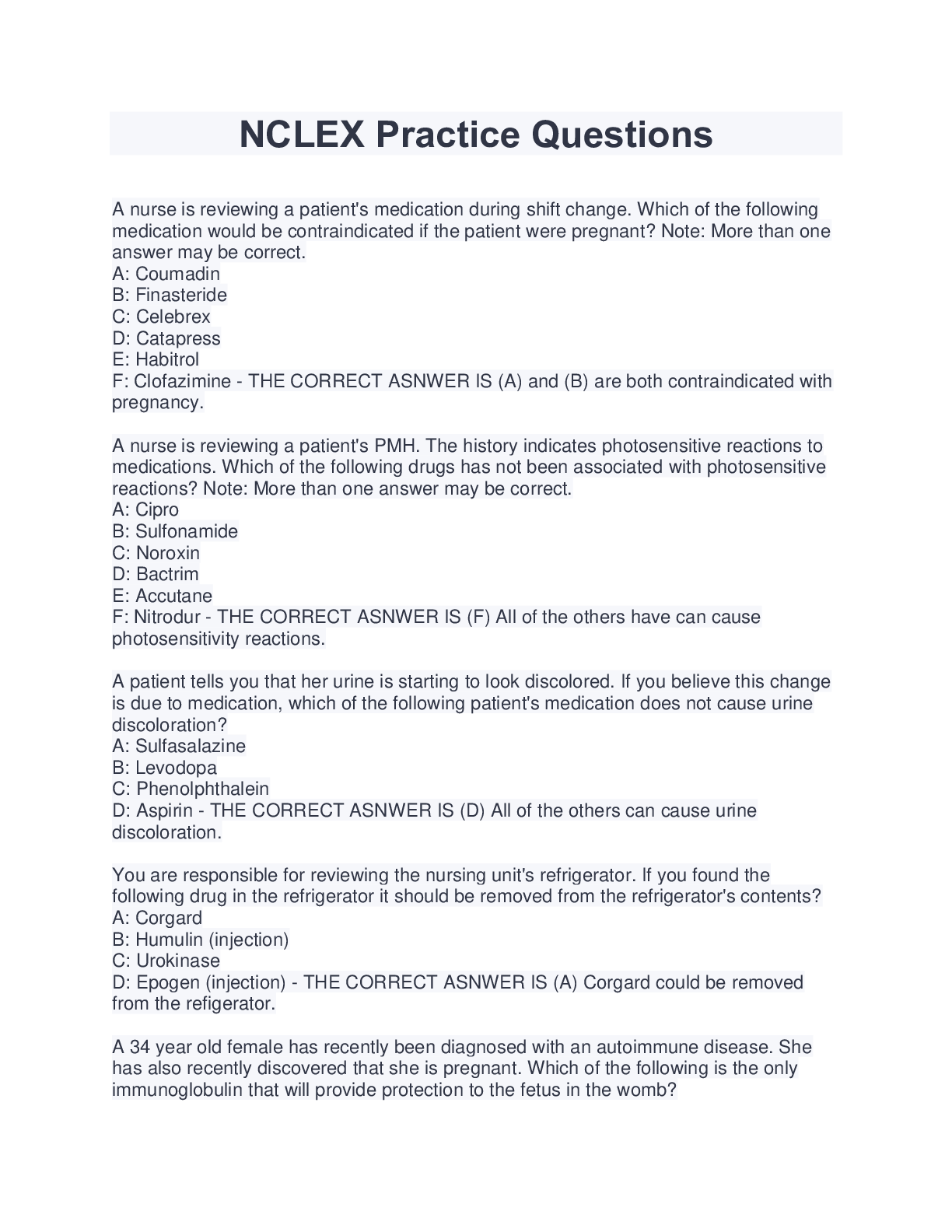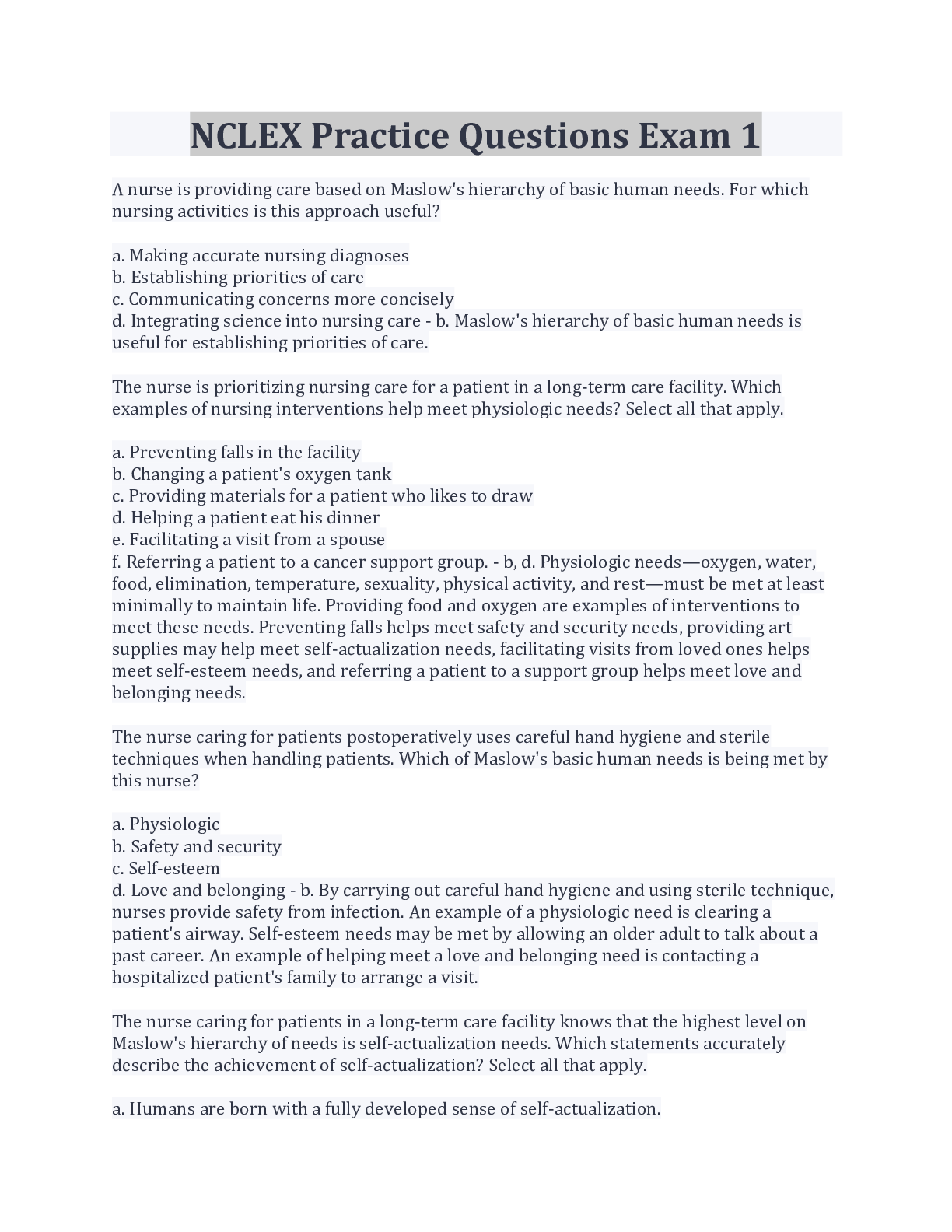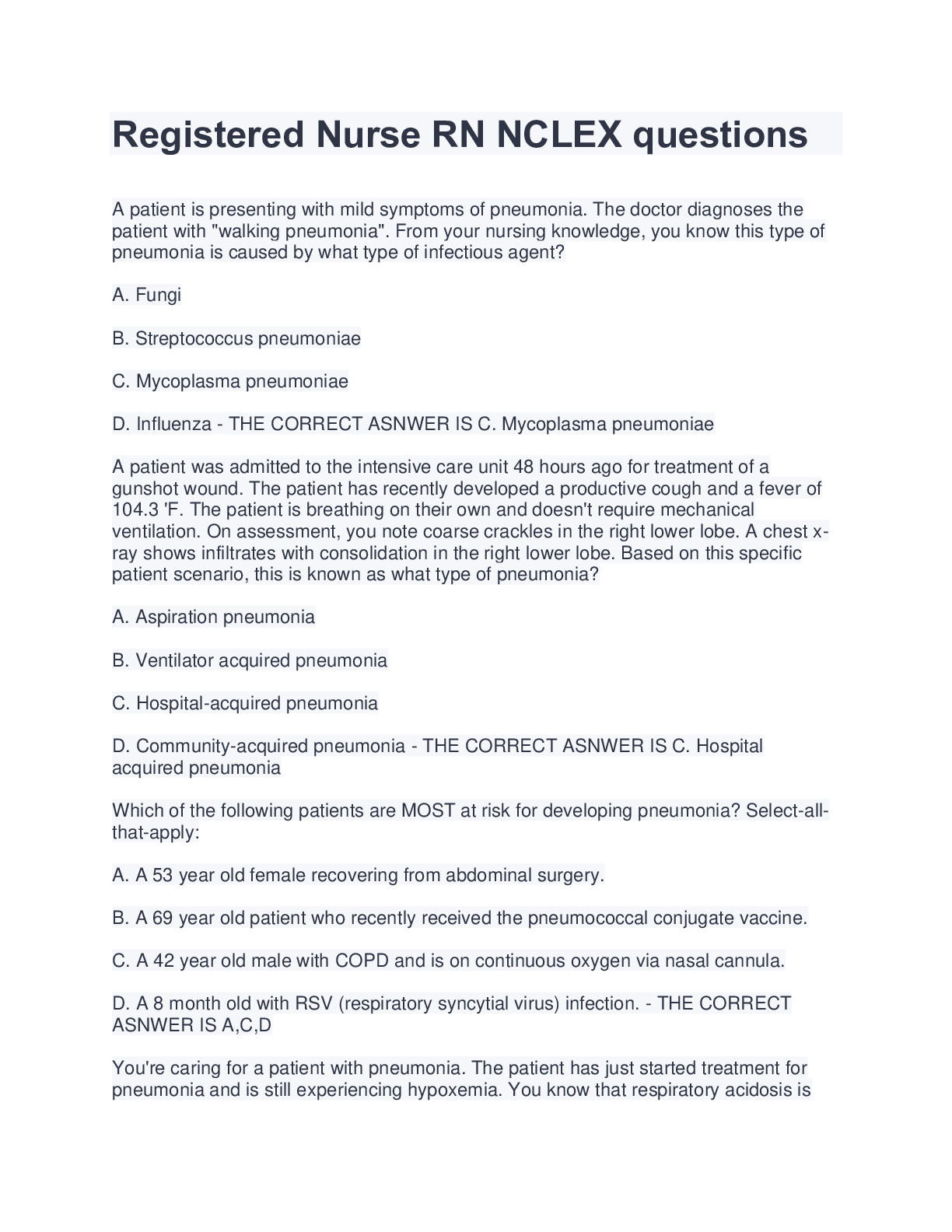*NURSING > NCLEX > NCLEX RN Exam (GRADE A) Questions and Answer Solutions | 100% Guaranteed Pass (All)
NCLEX RN Exam (GRADE A) Questions and Answer Solutions | 100% Guaranteed Pass
Document Content and Description Below
NCLEX RN EXAM 1. Which of the following clients is at a higher risk of developing oral health problems? a. A pregnant client b. A client with diabetes c. A client receiving chemotherapy d. B... oth b and c 2. Which nursing intervention is most appropriate to reduce environmental stimuli that may cause discomfort for a client? a. Loosen pressure dressings on wounds b. Use assistance to pull a client up in bed c. Check temperature of water used in a sponge bath d. Position the client prone 3. A client has developed a vitamin C deficiency. Which of the following symptoms might the nurse most likely see with this condition? a. Cracks at the corners of the mouth b. Altered mental status c. Bleeding gums and loose teeth d. Anorexia and diarrhea 4. Which of the following interventions should a nurse perform for a female client who is incontinent with impaired skin integrity? a. Turn the client at least every 8 hours b. Apply lotion to the skin before a bath c. Provide perineal care after the client uses the bathroom d. Bathe the client every 3 days 5. A nurse is caring for a client who died approximately one hour ago. The nurse notes that the client's temperature has decreased in the last hour since his death. Which of the following processes explains this phenomenon? a. Rigor mortis b. Postmortem decomposition c. Algor mortis d. Livor mortis 6. A nurse is calculating a client's intake and output. During the last shift, the client has had ½ cup of gelatin, a skinless chicken breast, 1 cup of green beans, and 300 cc of water. The client has urinated 250 cc and has had 2 bowel movements. What is this client's intake and output for this shift? a. 420 cc intake, 250 cc output b. 300 cc intake, 250 cc output c. 550 cc intake, 550 cc output d. 300 cc intake, 550 cc output 7. A nurse is caring for a client with ariboflavinosis. Which of the following foods should the nurse serve this client? a. Citrus fruits b. Milk c. Fish d. Potatoes 8. A client is taking a walk down the hallway when she suddenly realizes that she needs to use the restroom. Although she tries to make it to the bathroom on time, she is incontinent of urine before reaching the toilet. What type of incontinence does this situation represent? a. Reflex incontinence b. Urge incontinence c. Total incontinence d. Functional incontinence 9. Which of the following is an example of a positive effect of exercise on a client? a. Decreased basal metabolic rate b. Decreased venous return c. Decreased work of breathing d. Decreased gastric motility 10. You have taken the vital signs for your patient. They are normal for the patient. What should you do next? a. Report the vital signs to the doctor b. Write the vital signs on a scrap paper c. Call the family members d. Document them on the graphic VS form 11. Penny Thornton has had a stroke, or CVA. She is having difficulty eating on her own. Soon, she will be getting some assistive devices for eating meals. Which healthcare worker will be getting Penny these assistive devices? a. A physical therapist b. A speech therapist c. A social worker d. An occupational therapist 12. Which of the following is an example of emotional abuse? a. A slap to the person's hand b. Threatening the person c. Ignoring and isolating a person d. Leaving a patient soiled for hours 13. Which of the following is an example of emotional neglect? a. A slap to the person's hand b. Threatening the person c. Ignoring and isolating a person d. Leaving a patient soiled for hours 14. The duodenum: a. is the third section of the small intestine, which leads immediately to the colon. b. is the section of the stomach where the gall bladder delivers bile. c. is the section of the small intestine where the pancreas delivers insulin. d. None of the above. 15. The nurse is performing discharge teaching for Mrs. S after cardiac angioplasty. Her husband is present for the teaching. While explaining the prescription for antiplatelet medication to use at home, Mrs. S's husband states, "I don't think I can afford to refill that medication." What is the most appropriate response of the nurse? a. Don't worry, your insurance will cover it." b. I'll ask the physician if he can prescribe a medication that is more affordable." c. You should apply for Medicare to see if they can help you." d. This medication is essential for her care and should be given priority over all others that she is taking." 16. The discharge planning team is discussing plans for the dismissal of a 16- year old admitted for complications associated with asthma. The client's mother has not participated in any of the discharge planning process, but has stated that she wants to be involved. Which of the following reasons might prohibit this mother from participating in discharge planning? a. The client is an emancipated minor b. The mother has to work and is unavailable c. The client has a job and a driver's license d. The mother does not speak English 17. A nurse enters a client's room and finds her lying on the floor near the bathroom door. As the nurse provides assistance, the client states, "I thought I could get up on my own." What information must the nurse document in this situation? a. A statement explaining the condition the client was found in, quoting the client's words about the situation b. An explanation of how the fall happened and when the physician was notified c. An account of the conditions of the room that contributed to the client's fall d. A description of the client's condition and the reasons why she should have had assistance to the bathroom 18. Which of the following may be a cultural barrier that impacts a nurse's ability to provide care or education to the client? a. A nurse offers educational materials to a client that are written at an 8th grade reading level b. A Vietnamese woman wants to use steaming in addition to her prescription antibiotics c. A nurse uses pantomime to explain a procedure to a deaf client d. A Native American client requests a healing ritual before he will consider surgery 19. Which of the following is an example of low health literacy skills? a. A nurse's aide cannot calculate the correct IV rate for Ringer's lactate b. A client cannot read an admission form to sign it c. A nurse is unable to explain the dose, indications, side effects, and structural formula of carbamazepine d. A client does not understand the treatment for his cholecystectomy 20. A 39-year old woman presents for treatment of excessive vaginal bleeding after giving birth to twins one week ago. Which nursing diagnosis is most appropriate in this situation? a. Knowledge Deficit related to post-partum blood loss b. Self-Care Deficit related to post-partum neglect c. Fluid Volume Deficit related to post-partum hemorrhage d. Body Image Disturbance related to body changes after delivery 21. Mr. K is admitted to the orthopedic unit one morning in preparation for a total knee replacement to start in two hours. Which of the following is a priority topic to instruct this client on admission? a. The approximate length of the surgery b. The type of anticoagulants that will be prescribed c. The time of the next meal of solid food d. The length of time until the client can return to work 22. Which of the following is an example of the intervention phase of the individualized nursing care plan for a client who receives a colostomy after a bowel resection? a. Taking a health history and performing a physical exam prior to the procedure b. Instructing the client about how to care for his colostomy stoma c. Developing goals that state the client will ambulate three times a day d. Determining that the client may need more support at home after dismissal 23. Which method best describes the use of evidence-based practice? a. Reading and analyzing research reports to see how they can be implemented into nursing practice b. Collecting data to determine how efficiently nursing practice is contributing to quality care c. Monitoring unit practices to determine compliance with Joint Commission standards d. Using the most effective, current, and applicable information available to guide nursing care for the best of the clients. 24. A public health nurse discovers that many of the children in the neighborhood where she works are developing lead toxicity. She implements a program to screen for lead exposures among clients in the community. This is an example of: a. Social justice b. Policy resources c. Autonomy d. Moral justification 25. Which of the following is an example of whistle blowing? a. A nurse contacts administration about a colleague who takes supplies to use for a mission trip b. A client sues a nurse because she failed to call the physician about his wound infection c. A nursing assistant calls for help when a client falls out of bed d. A client developed a sacral pressure ulcer when he was not turned in bed for over four hours 26. Which situation might require an occupational health nurse consult? a. A nurse is injured from using incorrect body mechanics to lift a client b. A nurse receives a subpoena to testify in court about a client's case c. A client who has been injured in a diving accident needs assistance with planning rehabilitation and surgery d. A nursing unit is implementing a new electronic health record system 27. Which of the following is the most appropriate example of anticipatory guidance for a 16- year old who has been hospitalized for an ankle fracture? a. Changes associated with puberty b. Driving and staying safe c. The health hazards of smoking d. Social media influences 28. Which action represents the evaluation stage of the plan of care? a. The nurse assigns a nursing diagnosis of Impaired Skin Integrity related to diminished skin circulation b. The nurse assesses the client's vital signs and asks about symptoms c. The nurse determines that the client is not meeting his set outcomes and makes revisions d. The nurse discusses the client's health history 29. Which of the following screening tools have been found to have a high diagnostic accuracy for screening for intimate partner violence? a. Hurt, Insult, Threaten and Scream (HITS) b. Humiliation, Afraid, Rape, and Kick (HARK) c. Slapped, Threatened and Thrown (STaT) d. All the above 30. What is the relationship between HIPPA and technological advances? a. Technology helps to foster HIPPA confidentiality. b. Computers help us to share information with others. c. Computer screens are not visible to others in the area. d. Technology places us at risk for HIPPA violations. 31. Which technological advance is MOST likely to place you at risk for HIPPA violations? a. Social media b. Word processing programs c. Spreadsheets d. Clouds and SOEs 32. A patient is having a colposcopy procedure performed. How should the patient be instructed to prepare for the procedure? a. NPO for 8-12 hours before the procedure. b. D/C all HTN Rx for two days prior to the procedure. c. Take three Dulcolax tablets and two containers of Miralax the day before to clear out the lower GI system. d. None of the above prep is necessary for this type of procedure. 33. A physician is explaining a procedure to a patient that may cure her recurring Staph infection. The doctor explains how the procedure is done, what to expect, the odds of the procedure curing the infection, and possible side effects and risks. The physician is: a. Preparing the patient to give informed consent. b. Protecting HIPAA by listing all of the steps of the procedure with the risks involved. c. Not required to inform the patient of any alternative therapies. d. None of the above. 34. Teresa is an 84-year-old with stage 4 ovarian cancer who has been admitted for a bowel obstruction. She recently stated that she has decided that she doesn't want any further aggressive care and is requesting to be placed under hospice care. Her husband and daughter are supportive of her decision. She spoke with her oncologist about it, and he stated that he did not agree, and wrote orders on her chart for chemotherapy. What would be the best first response to this situation? a. Give the patient a list of other oncologists b. Tell the family to report the doctor to the state quality board c. Notify the doctor that the patient refuses the chemotherapy d. Give the patient hospice information 35. Upon entering an elderly patient's room, you find a research assistant with a clipboard, obtaining consent to participate in a new study. After signing the form, the patient begins to ask questions about the study. The assistant smiles and says, "Don't worry about all that, we'll take good care of you. Now enjoy the chocolate I brought." What should your first response be? a. Ignore the patient's questions b. Stop the assistant and question the consent c. Notify the nurse manager d. Notify the research department 36. Monica is a 28-year-old nurse who had been admitted to the hospital after a near-drowning in which she suffered cardiac arrest and hypoxic encephalopathy. She has been stabilized and has a tracheostomy to room air. She has been on the general floor for several weeks, is in a persistent vegetative state, and has a very poor prognosis for any improvement in her neurological status. Monica had previously signed a living will, which indicated that she did not wish to receive enteral feedings to be kept alive if she had a terminal condition or was in a persistent vegetative state from other causes. Her parents have decided to move her to the hospice unit and have given permission for removal of her feeding tube. The patient care technician who has been caring for Monica is very distressed over this decision and feels that the parents are "killing" her. What would be an appropriate initial response? a. This will relieve the burden for her parents." b. Her parents have a right to make decisions for their child." c. Monica has stated her wishes and they should be honored." d. The ethics committee should be consulted." 37. Jack is a 2-month-old with a diagnosis of spinal muscular atrophy (SMA) type I. He has been admitted to the hospital for progressive respiratory difficulty. His parents have been informed that if he is not placed on ventilatory support, he will continue to decompensate and die of respiratory failure. Jack's physician discusses the poor prognosis of Jack's condition, and tells the parents that he will not be able to be removed from ventilatory support once it is initiated, due to his progressive neurological disease. After much discussion, the parents have decided to decline ventilatory support, agree to a do not resuscitate (DNR) order, and request hospice care for Jack. Another parent heard them discussing Jack's situation in the waiting room and says she could never do that to her baby. What is the most appropriate response to this parent? a. You never know what you'll do until you're in that situation." b. I can't discuss another patient's situation." c. They have been through too much already." d. You can contact administration with your concerns." 38. You have noticed that the last several patients you have cared for have had questionable blood pressure readings from their arterial lines. When checked against cuff pressures, a discrepancy has been noted, and further investigation has revealed faulty transducers. This is not the first product issue with this company. What positive step could you take to help resolve this situation? a. Use the old stock from a previous company b. Verify the cuff pressures every hour to ensure accuracy c. Notify the risk manager d. Form a peer workgroup to evaluate new products 39. The family of a patient who is receiving therapeutic hypothermia states they do not understand why the patient is being kept so cold. What objective information can you provide to help address their concerns? a. Let them talk to another patient who has had the same therapy b. Provide research-based information about therapeutic hypothermia c. Connect them with the nurse manager d. Call the physician and ask him to talk to the family 40. A family member is complaining that the lights are too dim in the middle of the night when she comes in to visit her husband. What is the most objective response? a. Patients sleep better with the lights dimmed." b. The nightshift nurses prefer to work with less light." c. It's time for him to sleep, and you should, too." d. There's a reason we do that. Let me share a research study with you." 41. You are attempting to teach the wife of a Greek patient how to administer his gastrostomy tube feedings once he returns home. She smiles and nods through your explanations, but when you ask her for a return demonstration, she looks confused and shakes her head. Her daughter enters the room and states that she does not speak English. What would be most helpful in this situation? a. Teach the daughter instead b. Teach both and ask the daughter to translate for you c. Contact a home health agency to provide care d. Provide a pamphlet with detailed instructions 42. What is a key principle of patient teaching that must take place to ensure patient safety? a. Family members should be present b. Teaching must be documented c. Understanding must be confirmed d. Teaching should be provided by multiple staff members 43. A client with adrenal insufficiency has a potassium level of 7.2 mEq/L. Which of the following signs or symptoms might the client exhibit with this result? a. Peaked T waves on the ECG b. Muscle spasms c. Constipation d. A prominent U wave on the ECG 44. A client is having difficulties reading an educational pamphlet. He cannot find his glasses. In order to read the words, he must hold the pamphlet at arm's length, which allows him to read the information. Which vision deficit does this client most likely suffer from? a. Cataracts b. Glaucoma c. Astigmatism d. Presbyopia 45. A nurse is caring for Mrs. T, a client with expressive aphasia. During a bath, she begins to gesture wildly and point toward the bath water, yet is unable to say anything. Which response from the nurse is most appropriate? a. Is something wrong with the bath water?" b. Just calm down, we'll finish your bath soon." c. Are you trying to tell me something?" d. Shall I turn on the television?" 46. A nurse is assisting a client with shampooing his hair while he is still in bed. While helping the client, the nurse raises the bed to approximately the level of her waist. What is the rationale for this action? a. To prevent shampoo from getting into the client's eyes b. To allow excess water to run off the edge of the bed c. To decrease strain on the nurse's back d. To prevent the client's hair from developing tangles 47. Which of the following signs or symptoms indicates a possible nutritional deficiency? a. Subcutaneous fat at the waist and abdomen b. Presence of papillae on the surface of the tongue c. Straight arms and legs d. Pale conjunctiva 48. A nurse is preparing to insert a small-bore nasogastric feeding tube for a client's enteral feedings. In which method does the nurse measure the correct length of the tube? a. From the tip of the nose to the xiphoid process b. From the tip of the nose to the earlobe to the xiphoid process c. From the earlobe to the xiphoid process d. From the tip of the nose to the earlobe to the umbilicus 49. One major difference between long term care and respite centers is the fact that long term care facilities: a. provide only physical care and respite centers give both physical and emotional care. b. provide care for residents on a long term basis and respite centers offer only outpatient services. c. provide care for residents on a long term basis and respite centers offer only temporary services. d. There is no difference. Long term care and respite care are the same. 50. A nurse is assisting Mrs. K, a client who is undergoing a lumbar puncture. Which of the following elements should the nurse use to instruct Mrs. K about this procedure? a. A lumbar puncture takes a sample of blood from the back, which will be analyzed by the lab b. The physician will insert a needle at the level of L4-L5 in the spinal cord c. Mrs. K should lie flat on her back for 24 hours following the procedure d. The risks of the procedure include nausea, rash, and hypotension 51. A nurse is caring for a client who has a right-sided chest tube. The chest tube shows 50 cc of serosanguinous fluid in the collection chamber and air bubbles are collecting in the water seal chamber. Which action is most appropriate of the nurse at this time? a. Do nothing; this is a normal response b. Strip the tubing to remove any clots c. Place a clamp on the tube near the client's chest d. Remove the collection chamber and connect the tubing to a new device 52. A nurse is caring for a client with a broken femur who is in a traction splint in bed. All of the following interventions are part of care of this client EXCEPT: a. Palpating the temperature of both feet b. Evaluating pulses bilaterally c. Turning the client to a side-lying position d. Relieving heel pressure by placing a pillow under the foot 53. A client is preparing to undergo a cystoscopy for stones. Which of the following statements indicates that the client understands the procedure? a. I better drink a lot of fluid now because I won't be able to after the test." b. I will probably see a little blood when I urinate." c. I will be able to go home after 3 days in the hospital." d. I won't need any pain medicine; this probably will not hurt." 54. Which of the following conditions may warrant a serum creatinine level? a. Rhabdomyolysis b. Digitalis toxicity c. Glomerulonephritis d. All answers are correct 55. Which nursing intervention is most appropriate to maintain the patency of a client's nasogastric tube? a. Maintain constant connection to low-intermittent suction b. Irrigate the tube as per physician order c. Suction the mouth and nose every shift d. Perform a daily fecal occult blood sample 56. A nurse is caring for a client who is having blood tests and who has an elevated lymphocyte level. Based on knowledge of cellular components, the nurse knows that these cells: a. Contain histamine and provide protection during allergic reactions b. Are involved in phagocytosis c. Provide protection and immunity against foreign substances d. Carry hemoglobin and oxygen to body tissues 57. Mrs. F has been diagnosed with hyperparathyroidism. Which of the following complications is Mrs. F at highest risk of developing? a. Hyponatremia b. Hypocalcemia c. Hypermagnesemia d. Hypercalcemia 58. Elderly patients are more prone to dehydration than younger people because the elderly . a. drink more coffee and tea b. have more stomach mucus production c. have more saliva d. have less sense of thirst 59. You are turning your patient in bed and you see that this confused and lethargic patient had loose car keys and lipstick in the bed and had been lying on them. What is this person at risk for because of all three of these factors: the confusion, lethargy and items in the bed? a. Falls b. Skin breakdown c. Apnea d. Lack of mobility 60. Select the age group that is coupled with an infectious disease that is most common in this age group. a. Infants: High billirubin b. Pre-School and School Age Children: Shingles c. Young Adults and Teenagers: Sexually transmitted diseases d. The Elderly: Malaria 61. A complication of osteoporosis is . a. rheumatoid arthritis b. gouty arthritis c. dorsal flexion d. joint deformity 62. One of the complications of complete bed rest and immobility is which of the following? a. Plantar flexion. b. Dorsal flexion c. Extension contractures d. Adduction contractures 63. A nurse finds one of her clients unresponsive in his room. He is not breathing and does not have a pulse. After calling for help, what is the next action of the nurse? a. Administer 2 ventilations b. Perform a head-tilt, chin lift to open the airway c. Begin chest compressions d. Perform a jaw thrust to open the airway 64. A nurse is caring for a client with severe mitral regurgitation and decreased cardiac output. The nurse assesses the client for mental status changes. What is the rationale for this intervention? a. Decreased cardiac output can cause hypoxia to the brain b. Mental status changes may be a side effect of the client's medication c. Mitral regurgitation is a complication associated with some neurological disorders d. The client may be confused about his diagnosis 65. A client is undergoing radiation therapy for treatment of thyroid cancer. Following the radiation, the client develops xerostomia. Which of the following best describes this condition? a. Cracks in the corners of the mouth b. Peeling skin from the tongue and gums c. Increased dental caries d. Dry mouth 66. A nurse is providing information for a woman who is 36 weeks' pregnant and who has hepatitis B. Which of the following statements from the client indicates understanding of this condition? a. Now I know I will need a cesarean section." b. My baby will need two shots soon after his birth." c. I will not be able to breastfeed." d. My baby's father does not need testing; I know I am the one with hepatitis." 67. A nurse is educating a client who was recently diagnosed with diverticulosis. What types of foods should the nurse recommend for this client? a. Whole grain cereal b. Eggs c. Cottage cheese d. Fish 68. A client is in need of hemodialysis for end-stage renal failure. The physician has inserted an AV fistula. Which of the following nursing interventions are appropriate when caring for this access site? a. Assess for clotting in fistula tubing b. Apply a dressing over the fistula site c. Assess for a bruit or thrill at the site of the fistula d. Assess circulation proximal to the fistula site 69. A client is brought into the emergency room where the physician suspects that he has cardiac tamponade. Based on this diagnosis, the nurse would expect to see which of the following signs or symptoms in this client? a. Fever, fatigue, malaise b. Hypotension and distended neck veins c. Cough and hemoptysis d. Numbness and tingling in the extremities 70. Based on Mr. W's diagnosis of MAC, which of the following information should be provided to this client? a. He should be started on antiretroviral therapy as ordered b. He is no longer just HIV-positive, he most likely has AIDS c. He should be tested for other illnesses, such as anemia d. Both b and c 71. All of the following are complications associated with hypothermia during the perioperative period EXCEPT: a. Decreased blood urea nitrogen levels b. Cardiac arrhythmias c. Decreased immunity d. Increased oxygen needs 72. A nurse is caring for a client who had a bone marrow transplant two weeks ago. Which of the following is most likely to cause an infection during this time period? a. Cytomegalovirus b. Varicella zoster virus c. Herpes simplex virus d. Hepatitis B virus 73. When reading a lab report, you notice that a patient's sample is described as having anisocytosis. Which of the following most accurately describes the patient's condition? a. The patient has an abnormal condition of skin cells. b. The patient's red blood cells vary in size. c. The patient has a high level of fat cells and is obese. d. The patient's cells are indicative of necrosis. 74. A patient with Bell's Palsy would have which of the following complaints? a. Paralysis of the right or left arm b. Malfunction of a certain cranial nerve c. A sub-condition of Cerebral Palsy d. A side effect of a stroke 75. A pathologic condition described as, "Increased intraocular pressure of the eye," is: a. Detached Retina b. Fovea Centralis c. Presbyopia d. Glaucoma 76. A physician believes that a patient may be experiencing pancreatitis. Which of the following tests would be best to diagnose this condition? a. CK and Troponin b. BUN and Creatinine c. Amylase and Lipase d. HDL and LDL Cholesterol Levels 77. Which of the following is an example of client handling equipment? a. Wheelchair b. Height-adjustable bed c. Shower chair d. Call light 78. Which practice will help to reduce the risk of a needlestick injury? a. Only expose the end of the needle once ready to enter the room for the procedure b. Always place the cap back on a needle after it has been used c. Keep a sharps container nearby where it can be easily accessed d. Pass needles between nurses by using the hand-over technique 79. Which of the following is an organizational factor that affects workplace violence directed at nurses? a. Clients who have short hospital stays b. The presence of security guards c. Restricted client areas d. Understaffing of nursing personnel 80. Which of the following actions of the nurse is most appropriate to reduce the risk of infection during the post-operative period? a. Flush the central line with heparin at least every four hours b. Administer narcotic analgesics prn c. Remove the urinary catheter as soon as the client is ambulatory d. Order a high-protein diet for the client 81. A nurse is assessing a client who is post-op day #1 after a hemilaminectomy. The nurse removes the dressing as ordered and notes that the incision appears slightly red, with a small amount of serous drainage coming from the site. The edges of the incision are approximated. What is the next action of the nurse? a. Assist the client to shower as ordered and monitor the site for further changes b. Instruct the client to lie prone to allow the site to dry c. Place antibiotic ointment and a sterile dressing over the site d. Notify the physician for an antibiotic order 82. A nurse is preparing to administer a dose of platelets to a client. Which of the following actions must the nurse perform before giving the platelets? a. Start an IV of ½ Normal Saline to administer with the platelets b. Ensure the container with the platelets is intact and not damaged c. Verify the client's name and address d. Check the client's chart to ensure he is not taking any antibiotics 83. Which of the following is an example of an environmental hazard that may put the nurse at risk of injury? a. Loud noise from the hospital maintenance system b. Airborne powder that contains latex c. Chemicals containing ethylene oxide d. All of the above e. Both b and c only 84. MSDS sheets: a. Contain the ordering information for each piece of equipment in the office. b. Are required by OSHA to be accessible to all employees of the office. c. Can be used to treat patients who have been injured in equipment accidents. d. None of the above. 85. The most virulent blood borne pathogen is: (Choose the BEST answer.) a. HCV b. HPV c. HIV d. HBV 86. The NFPA diamond has four colors. The blue diamond: a. indicates hazards to health. b. designates that it is safe to use water to put out this type of fire. c. indicates that ice is necessary to treat an injury with this type of chemical. d. indicates that the chemical may be incinerated upon disposal. 87. Which would be the first step when a patient passes out at the front desk? a. Call 911. b. Initiate CPR. c. Shake the patient and ask if he is ok. d. Check for a pulse. 88. When performing CPR, at what rate should chest compressions be applied? a. 100 per minute b. 60 per minute c. As quickly as possible. d. 200 per minute 89. Which acronym would BEST describe the procedure for assessing a patient that appears unconscious? a. WBC b. QRS c. XYZ d. ABC 90. A term that refers to a comprehensive set of thoughts or images of oneself is called: a. Global self b. Core self-concept c. Personal identity d. Ideal self 91. Which of the following interventions is most appropriate when supporting the psychosocial needs of a client who is experiencing negative side effects associated with chemotherapy? a. Read the client's discharge instructions well in advance of dismissal b. Provide medications to reduce nausea and vomiting c. Give simple instructions about self-care while in the hospital d. Determine the levels of support from significant others 92. Which of the following interventions is most appropriate when working with the family of a client who is being treated for substance abuse? a. Advocate for the client before the family b. Provide referrals for community resources and support groups c. Take the side of the family before the client d. Both b and c 93. A term used to describe members of the same group based on physiological characteristics, such as skin color or body structure is known as: a. Ethnicity b. Culture c. Race d. Minority 94. Which of the following is an example of non-reversible dementia? a. Pick's disease b. Syphilis c. Encephalopathy d. Hyperthyroidism 95. Which is a true statement regarding stress related disorders? a. Stress related disorders are only caused by stress b. Symptoms of stress related disorders would not exist if the client was not experiencing stress c. Stress related disorders are also called psychophysiologic disorders d. None of the above 96. Which of the following nursing outcomes is most appropriate during the crisis stage of caring for a victim of domestic violence? a. The client will verbalize community resources from which to seek shelter after discharge b. The client will write a plan to keep herself and her children safe c. The client will contact an attorney for help with pressing charges d. The client will be safe and receive treatment for injuries 97. Which of the following is a symptom associated with sensory overload? a. Disorientation b. Drowsiness c. Emotional lability d. Depression 98. A nurse is providing care for a client who has just died. Her son states, "She was the most wonderful mother. There was no one who was a better mother than she was. She was perfect." Which stage of grief is this son experiencing? a. Denial b. Anger c. Idealization d. Shock 99. Of the following, which would NOT be helpful to include when developing Jerry's plan of care? a. Limiting choices b. Providing structure c. Encouraging patient input d. Ensuring availability of prn medications 100. Patients have a right to . a. only enough information so they can comply with care b. ALL of their health related information c. small amounts of information so they do not get nervous d. moderate amounts of information unless they are old 101. Your patient ate an 8 ounce cup of Italian ice. How much will you record on the patient's Intake and Output form in terms of this patient's fluid intake? a. 240 cc b. 120 cc c. 8 cc d. 0 cc because Italian ice is not a fluid. 102. You are getting the patient ready to eat. The patient is on complete bed rest. You will put the head of the bed up at degrees or more. a. 10 b. 15 c. 20 d. 30 103. Cheryl M. has a serious swallowing disorder. She has asked you for a glass of water. The doctor has ordered honey thickness fluids for her. Water is not a honey thickness fluid. It is much thinner. What should you do? a. Tell the resident that she cannot have water. b. Give her applesauce instead of the water. c. Tell Cheryl that she is NPO until midnight. d. Thicken the water and give it to her. 104. You have been asked to record the amount of food that the person has eaten during each meal. What kinds of words or numbers would you use to record this food intake? a. A little, a moderate amount or all of the meal b. 50 cc, 100 cc or 500 cc of the meal c. 25%, 50% or 100% of the meal d. Either a or c 105. The heat-regulating center of the brain is the: a. Hypothalamus b. Pituitary Gland c. Pons d. Medulla Oblongata 106. The anatomic structure located in the middle of the heart which separates the right and left ventricles is the: a. Septum b. Sputum c. Separatator d. None of the above. 107. Which of the following boney landmarks is described by, "large, blunt, irregularly shaped process, such as that found on the lateral aspect of the proximal femur"? a. Tubercle b. Tuberosity c. Condyle d. Trochanter 108. The Atlas and the Axis: a. are found in the vertebrae. b. can be described as being cervical. c. are the first two bones that form the column for the spine on the superior aspect. d. All of the above. 109. The body system that functions to maintain fluid balance, support immunity and contains the spleen is the: a. Lymphatic System b. Digestive System c. Urinary System d. Reproductive System 110. Of the following, which often triggers an episode of violence or aggression by the patient with a psychiatric diagnosis that may involve violent behavior? a. Obtaining a history b. Asking for input into care c. Enforcing rules d. Taking a walk 111. Which of the following medications would NOT be an appropriate prn medication for use during an episode of aggression or violence for the patient with a psychiatric diagnosis? a. Olanzapine b. Meperidine c. Ziprasidone d. Haloperidol 112. Which of the following is an appropriate tension-reduction intervention for the patient who may be escalating toward aggressive behavior? a. Asking to speak to someone b. Asking to be alone c. Listening to music d. All of the above 113. Causes which contribute to delirium are often remembered as an acronym of the same name. What cause does the E in DELIRIUM represent? a. EEG b. EKG c. Electrolytes d. Echocardiogram 114. A nurse is preparing to administer a rectal suppository to a client. After applying gloves, checking the client's identification band, and closing the door, what is the next step of the nurse? a. Assist the client to lie in the Trendelenburg position b. Unwrap the suppository and lubricate the end c. Remove gloves and wash hands d. Record the date, time, and amount of suppository to give 115. Mr. F has been prescribed isocarboxazid, a monoamine oxidase inhibitor, as part of treatment for depression. Which of the following foods should the nurse instruct the client to avoid while taking this drug? a. Wine b. Sweet potatoes c. Spinach d. Apple juice 116. A nurse is preparing to administer digoxin to a client who suffers from heart failure. What must the nurse consider before administering this medication? a. The presence of pitting edema in the lower extremities b. The sound of rales on lung auscultation c. The rate of the apical pulse d. The presence of jaundiced skin 117. A client has been taking his antianxiety medications for four years, even though he no longer struggles with acute anxiety. Instead, he has a routine of taking the medication each evening and feels better knowing that he has taken it. Which of the following best describes this action? a. Physiologic need b. Physiologic dependence c. Drug abuse d. Drug habituation 118. Which of the following is a disadvantage of taking medication through an oral route? a. The drug may be absorbed too rapidly b. The drug may have a bad taste c. The drug is more expensive to use d. Both a and b 119. One tablespoon of medication is equal to how many milliliters of fluid? a. 5 ml b. 15 ml c. 30 ml d. 60 ml 120. A nurse asks her coworker to administer Mr. J's 12pm medication because she is running behind. Which of the following information must the nurse verify with Mr. J before giving him his medication? a. His name and address b. His name and hospital identification number c. His name and room number d. His name and diagnosis 121. Which of the following is more likely to occur with aging as a complication of medication administration? a. Increased renal function b. Increased gastrointestinal absorption c. Increased visual acuity d. Increased ratio of fat compared to lean body mass 122. Which of the following interventions should the nurse consider when giving an oral medication to a child? a. Mix the medication with milk to mask the taste b. Dilute the medication in a glass of water c. Refeed the medication if the child pushes it out with his tongue d. Mix the medication in a food the child enjoys 123. Which of the following solutions is compatible with administration of packed red blood cells? a. Lactated Ringer's b. 0.9% Normal Saline c. D5 ½ Normal Saline d. Normosol-R 124. Which of the following is an example of a colloid solution? a. 5% Dextrose in water (D5W) b. Albumin c. Lactated Ringer's d. Normal Saline 125. Which of the following best describes the cognitive development of an 18- month old child? a. The child can follow one-part directions b. The child understands the concept of "forever" c. The child can name six body parts d. The child has an attention span of approximately 5 minutes 126. Which of the following is an example of a fine motor skill? a. Jumping on a trampoline b. Brushing hair c. Standing on one foot d. Climbing a ladder 127. A child is being discharged to home with a diagnosis of ringworm. Discharge instructions should include the information that: a. The infection is caused by a worm and cannot be passed from person to person. b. The infection is caused by a virus and can be passed from person to person. c. The infection is caused by a bacteria and cannot be passed from person to person. d. The infection is caused by a fungus and can be passed from person to person. 128. Physical bullying, among school aged children, threatens which of Maslow's needs? a. Physical needs b. Love and belonging needs c. Safety needs d. All of the above 129. Your patient has had a very full and rewarding life. She has had a lot of success in her personal and professional life. She has achieved all of her goals and she has maximized her potential. This patient can be best described as a person who has achieved Maslow's . a. self actualization b. exploration c. closeness d. protection ANSWER A: This person has moved along Maslow's hierarchy and is now 130. At the end of life, many people have a fear of . a. insects b. rejection c. acceptance d. being alone [Show More]
Last updated: 1 year ago
Preview 1 out of 38 pages
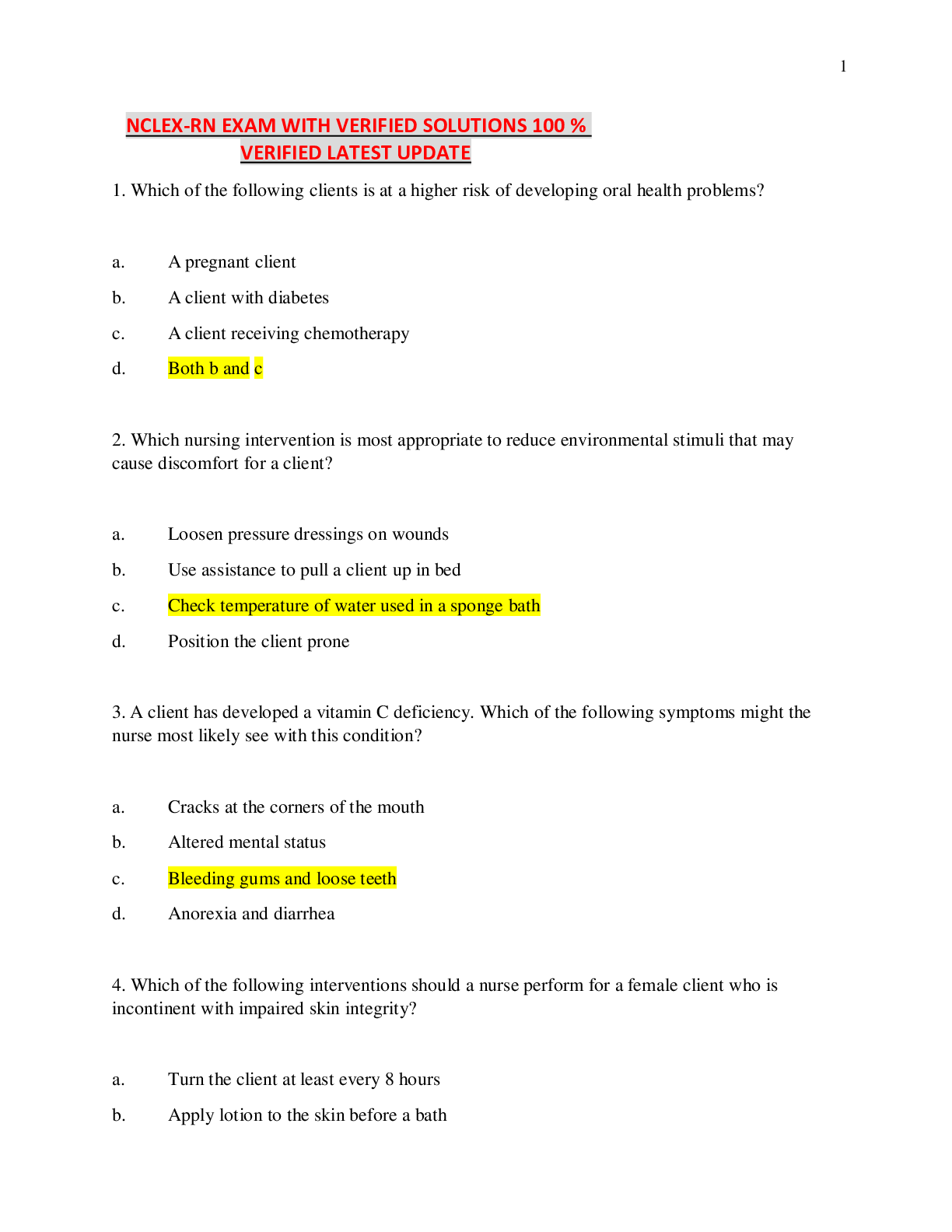
Reviews( 0 )
Document information
Connected school, study & course
About the document
Uploaded On
May 02, 2022
Number of pages
38
Written in
Additional information
This document has been written for:
Uploaded
May 02, 2022
Downloads
0
Views
37


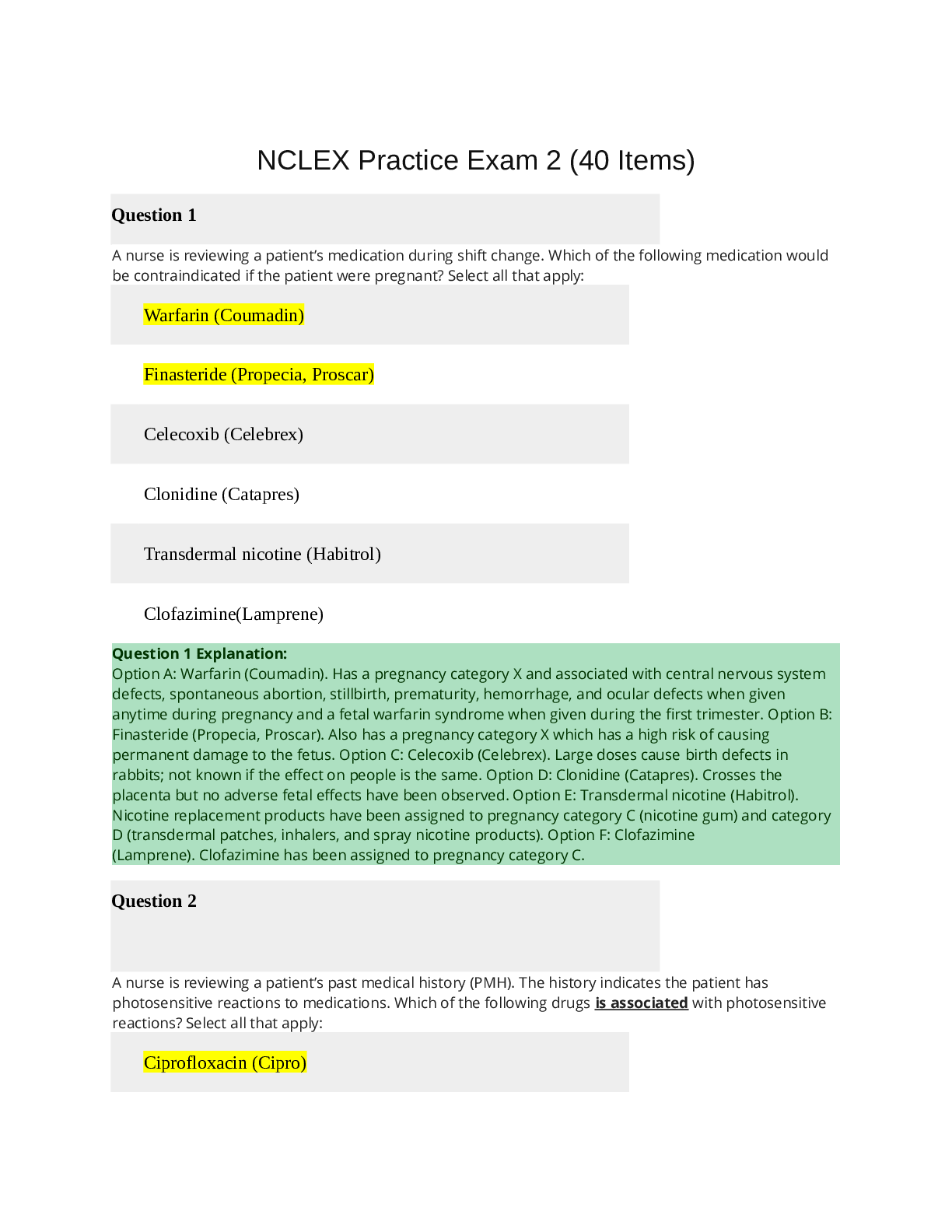
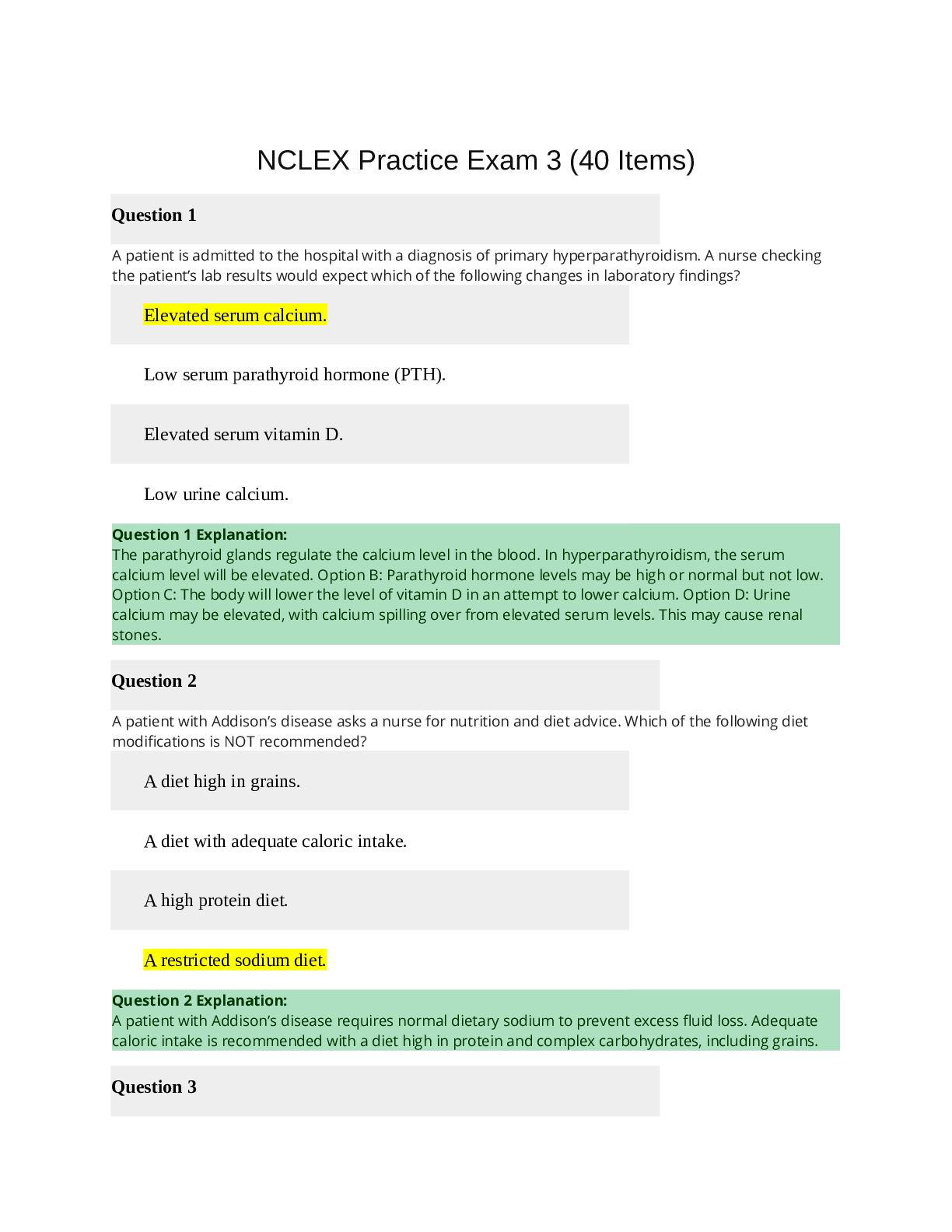
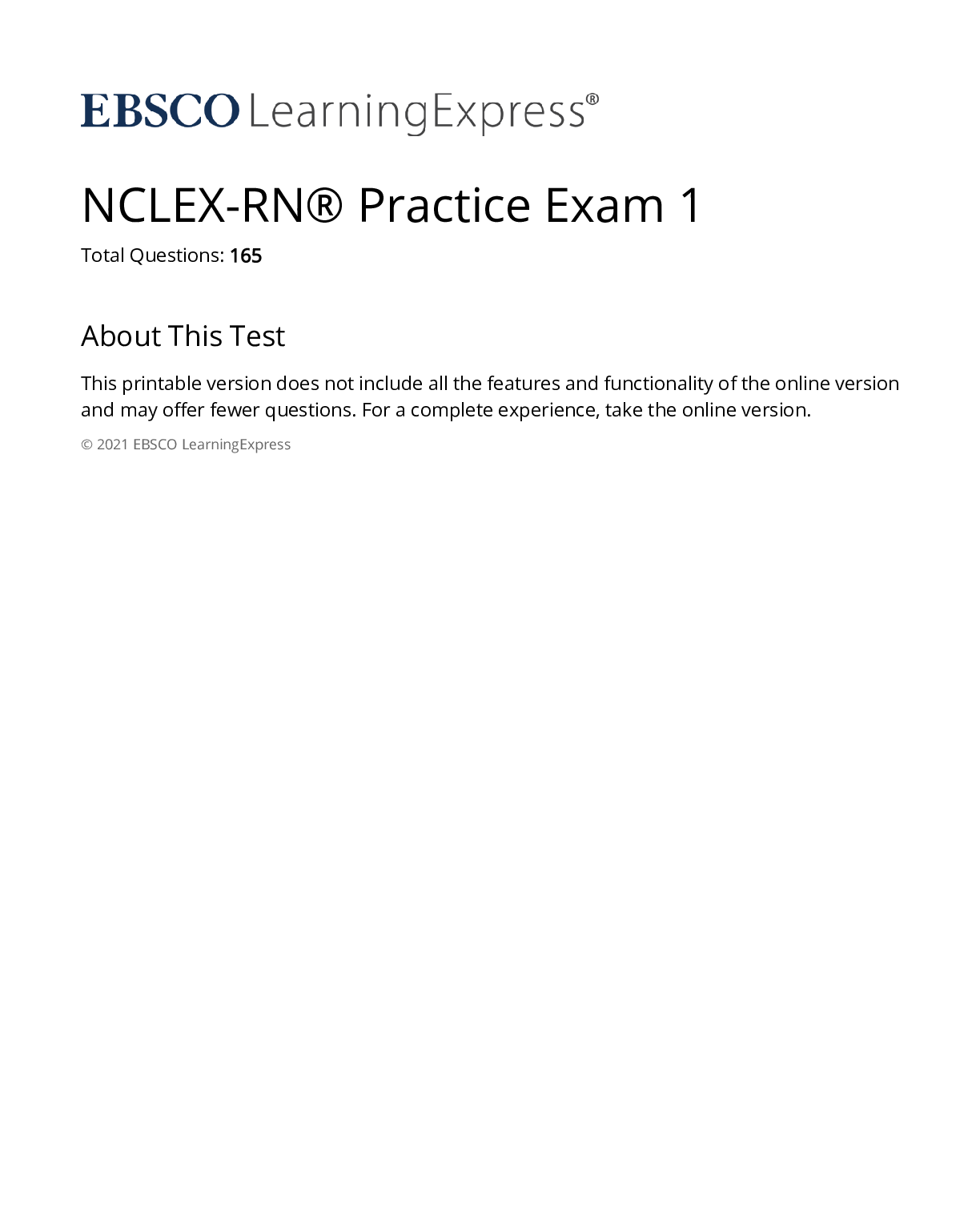

 (1).png)

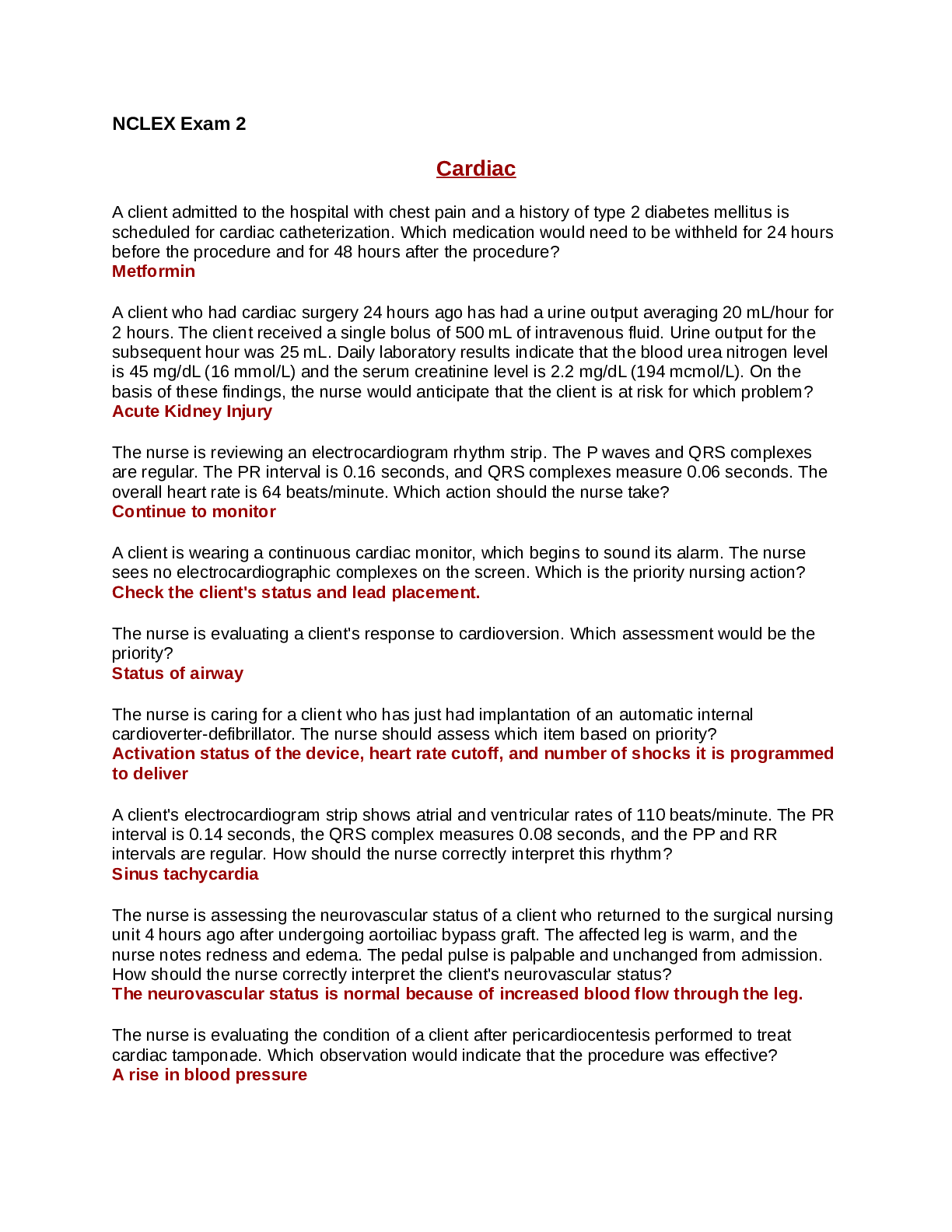
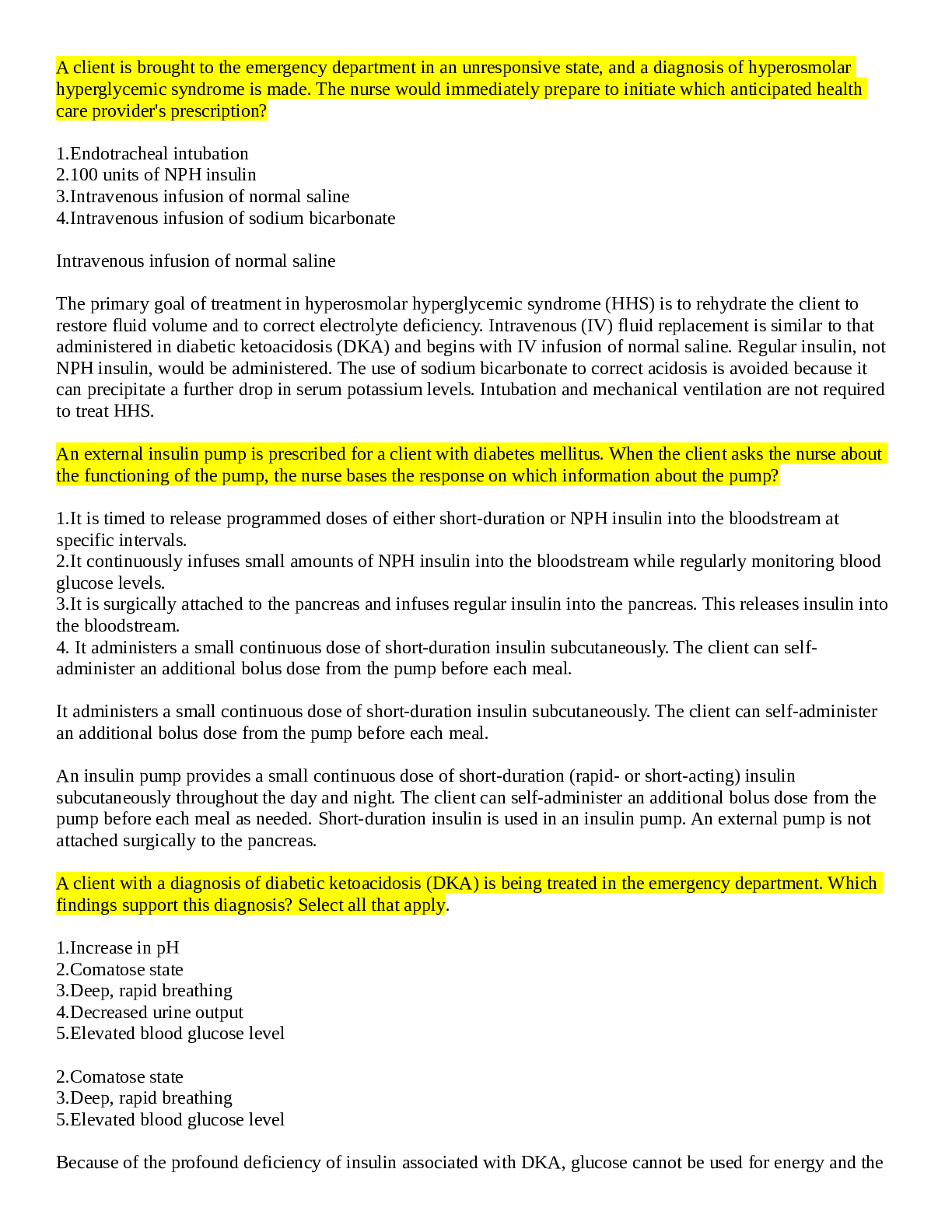
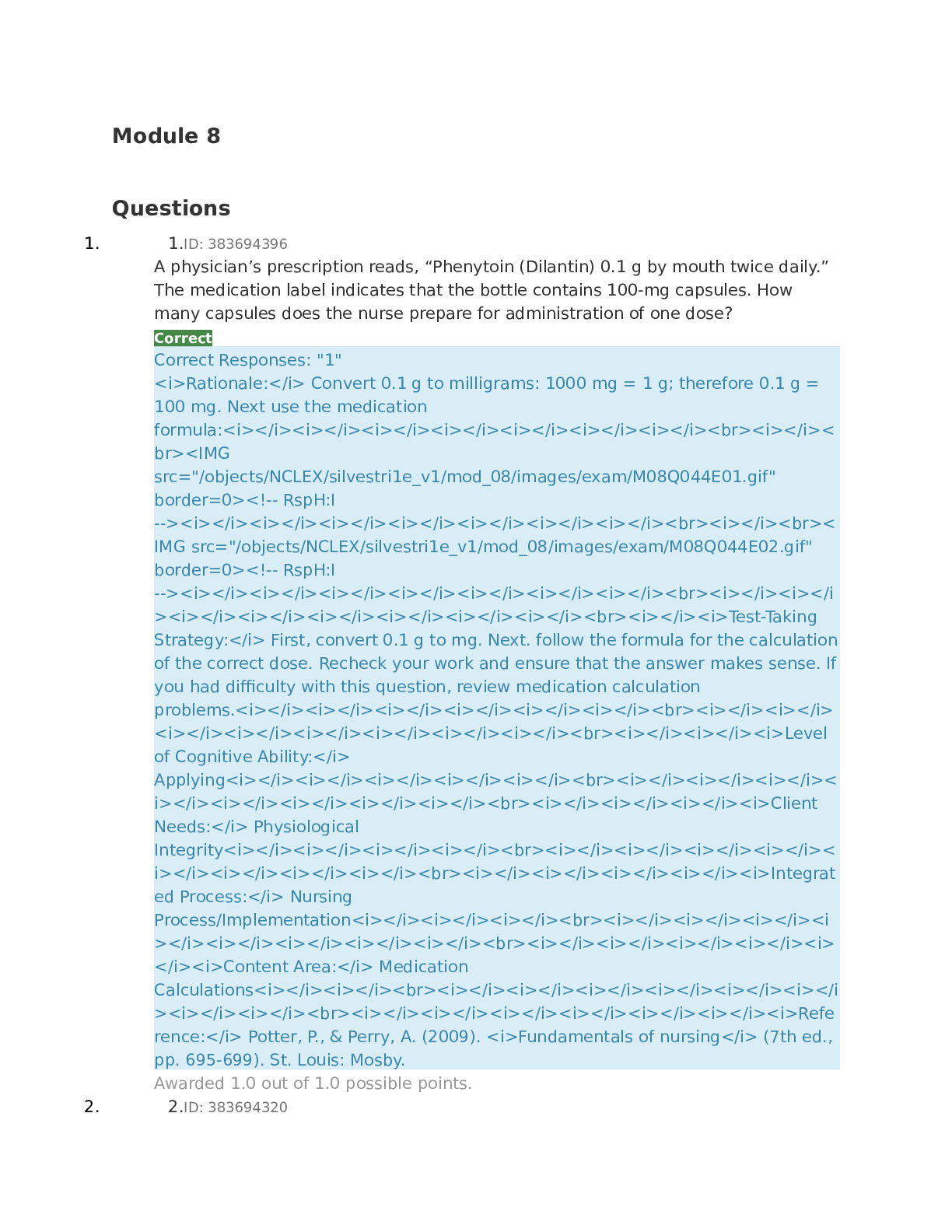
.png)
.png)

